Like Italian, Chinese, and Japanese food, Mexican cuisine is one of the most popular cuisines in the world. Visit any major city and you’re sure to find at least one Mexican restaurant. In my opinion, it’s one of the best cuisines in the world. UNESCO seems to agree.
In 2010, traditional Mexican cuisine was one of the first two cuisines given Intangible Cultural Heritage status by UNESCO. The other is French gastronomy. What that means is that traditional Mexican food is a cultural treasure that’s worth protecting and preserving.
We travel for food and Mexican cuisine is one of the biggest reasons why we chose to make Mexico our second home. After months of exploring the food in Mexico, this list could easily be much longer than it is now, but I wanted to keep it concise so I’ve pegged it to what we believe to be Mexico’s must-try dishes.
If you’re visiting Mexico and wondering what to eat in this vast (and vastly delicious) country, then these are 25 Mexican dishes that you shouldn’t miss.
FOOD IN MEXICO QUICK LINKS
If you’re planning a trip to Mexico and want to dive headfirst into the local cuisine, then you may be interested in joining a food tour or taking a cooking class.
TOURS & OTHER SERVICES
- Food Tours: Food Tours in Mexico
- Cooking Classes: Cooking Classes in Mexico
- SIM: Mexico SIM Card / eSIM
- Transportation: Mexico Bus Tickets
Save This on Pinterest!
No time to read this article on Mexican cuisine? Click on the save button and pin it for later!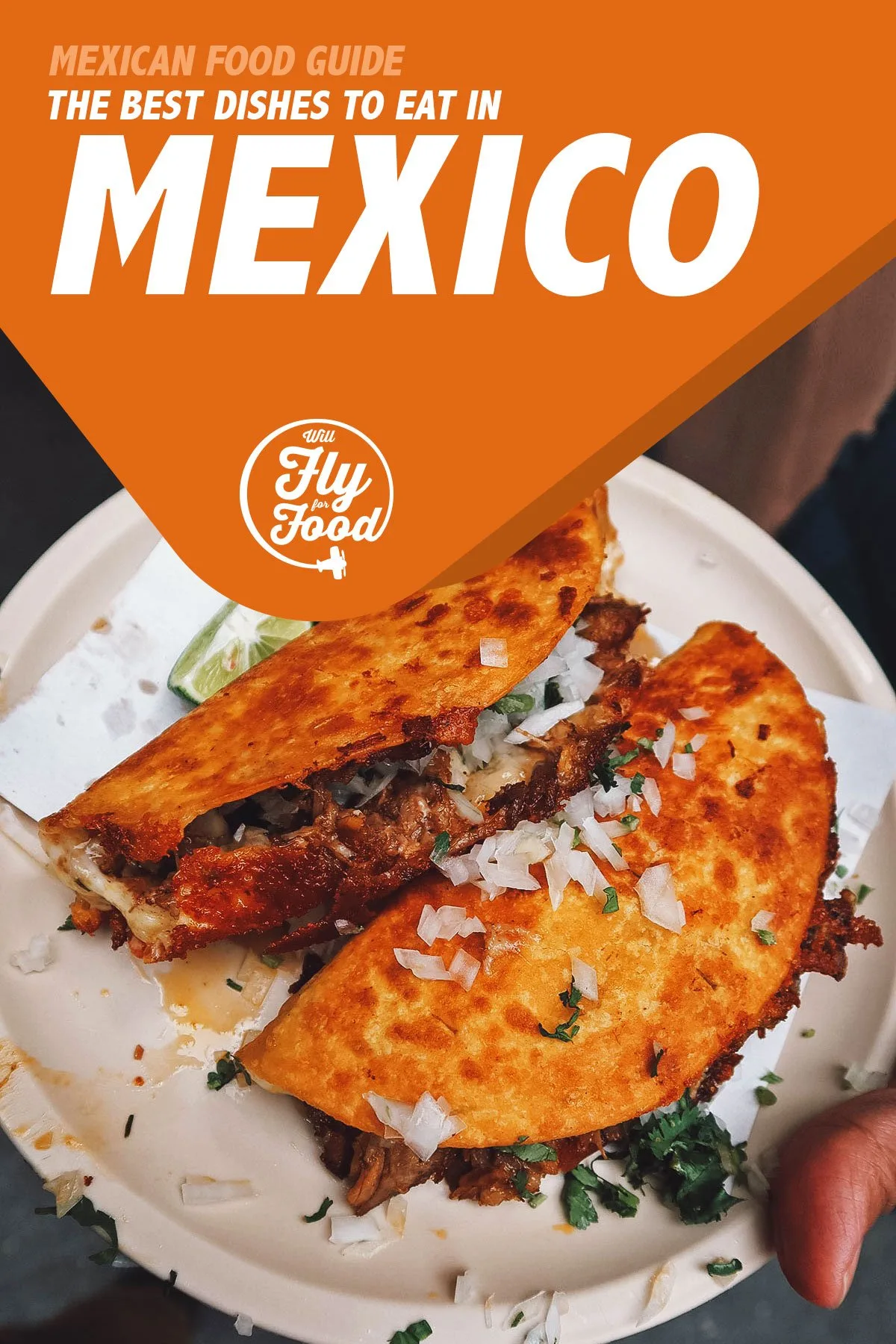
WHAT IS TRADITIONAL MEXICAN FOOD?
Mexican cuisine is an ancient cuisine that dates back thousands of years. Its earliest roots are in Mesoamerican cooking traditions that can be traced back to the time of the Aztecs and Mayans.
Corn (maize) and chili peppers are cornerstones in Mexican cooking. They’re used in a vast majority of Mexican food recipes along with other key ingredients like beans, avocados, cacao, tomatoes, tomatillos, agave, and cactus. Maize was domesticated by the Mayans who devised the process of nixtamalization, a method of preparing corn that remains a vital component in Mexican cooking.
After the Spanish conquest of the Aztec empire, new ingredients were introduced and incorporated into the cuisine like meat from domesticated animals (beef, pork, lamb, etc), dairy products, rice, sugar, and olive oil.
Waves of immigration would later follow which would bring in ingredients and cooking methods from other parts of the world like Asia, Africa, and the Middle East.
This mix of influences is what I love most about traditional Mexican food. It’s a cuisine with strong indigenous roots made more colorful by the infusion of foreign influences.
THE BEST OF MEXICAN CUISINE
This article on authentic Mexican food has been organized by category to make it easier to digest. Click on a link to jump to any section of the guide.
BREAKFAST DISHES
1. Chilaquiles
If you’re an early riser and enjoy trying different breakfast dishes from around the world, then you need to try chilaquiles. It’s one of the most popular Mexican dishes you’ll find on any breakfast menu in Mexico.
Depending on the region and cook, chilaquiles can be prepared in different ways but it typically consists of lightly fried corn tortillas served with salsa verde (green) or salsa rojo (red). It’s often garnished with onions, avocados, cilantro, crema, and queso fresco (fresh cheese).
No matter the city or state, chilaquiles is something you’re sure to find on any Mexican restaurant’s breakfast menu. Pictured below is a traditional version of chilaquiles verde from a restaurant in San Miguel de Allende. I’ve also had fancier versions made with sauces like mole almendrado (almond mole).
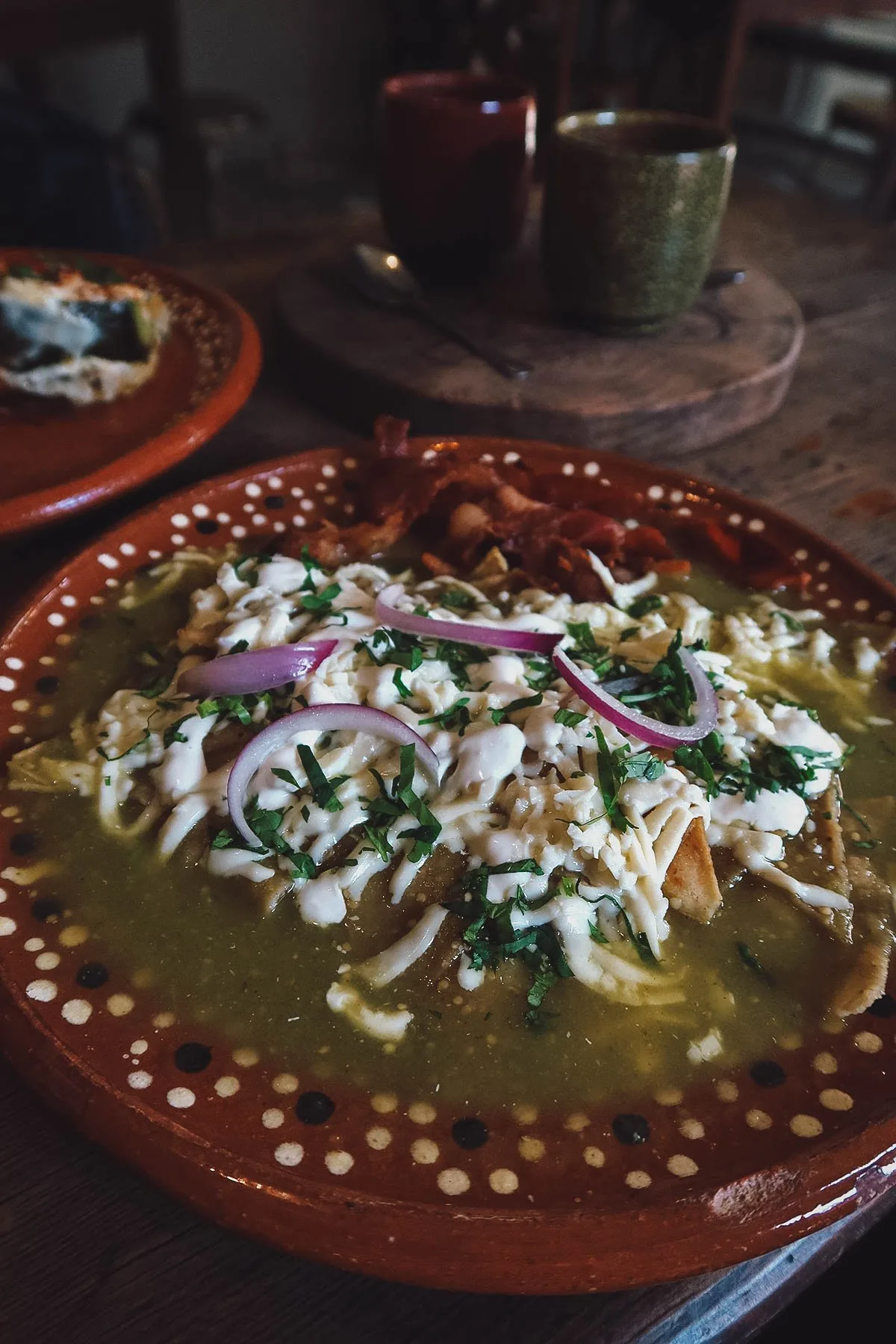
2. Huevos Motuleños
Huevos motuleños is another popular breakfast dish served at many Mexican restaurants. It’s a Yucatecan dish originally from the town of Motul in Yucatan state, but it’s something we often found on breakfast menus throughout Mexico.
Huevos motuleños consists of corn tortillas topped with black beans, cheese, fried eggs, and tomato sauce. Like chilaquiles, it can be made in a variety of ways depending on the cook.
This particular version from a restaurant in Valladolid was topped with peas, ham, and fried plantains. Delicious and filling, it’s one of the tastiest dishes you can have for breakfast in Mexico.
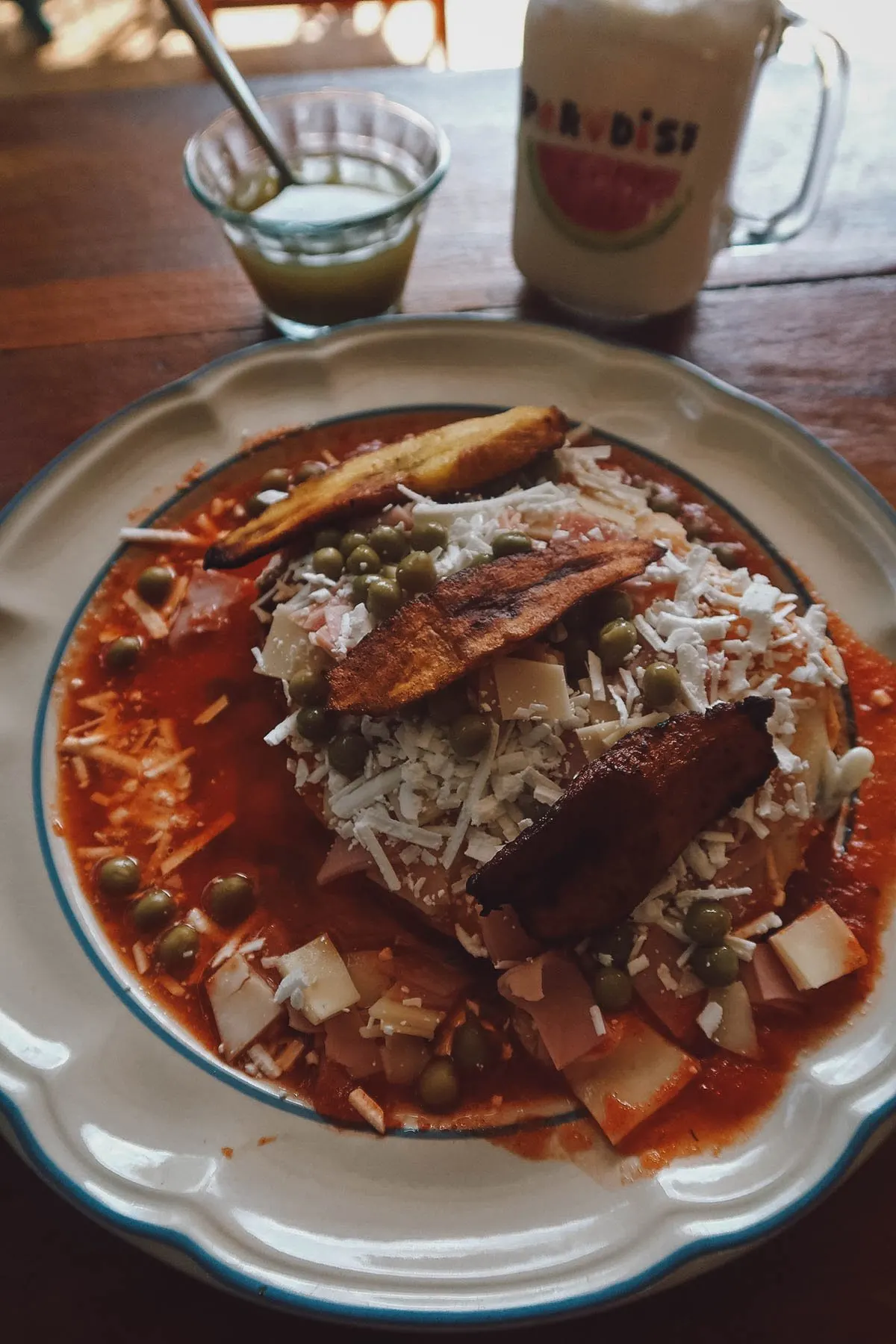
3. Enchiladas
Like tacos and burritos, enchiladas are among the most popular Mexican foods outside of Mexico. They consist of rolled corn tortillas stuffed with a variety of fillings like meat, beans, cheese, potatoes, and vegetables before being drenched in a sauce.
The version below called enchiladas suizas from a restaurant in Playa del Carmen is made with shredded chicken, manchego cheese, and green enchilada sauce. Many Mexican restaurants offer enchiladas topped with a variety of sauces made from beans, chili peppers, mole, and cheese.
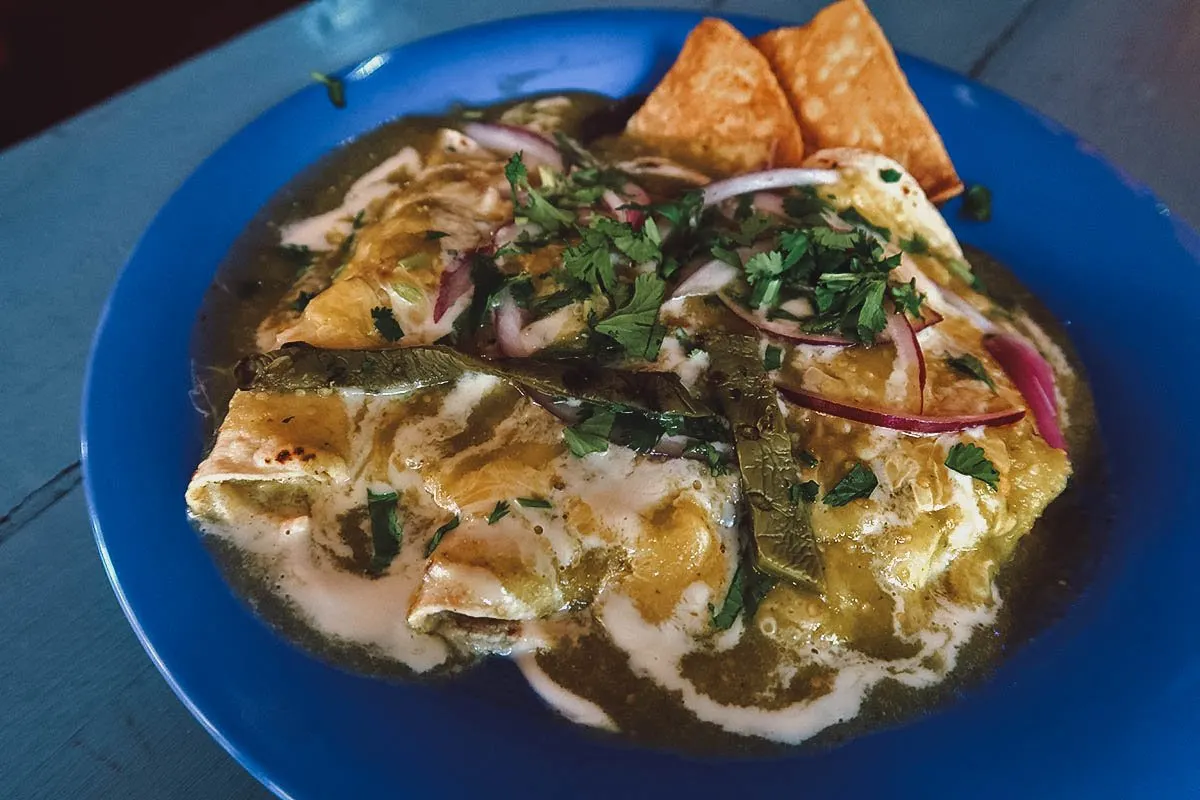
Enfrijoladas
Enfrijoladas are among the most common variety of enchilada you’ll find on restaurant menus in Mexico. Enfrijolada stems from the word frijol – meaning “bean” – and refers to a type of enchilada topped with refried beans.
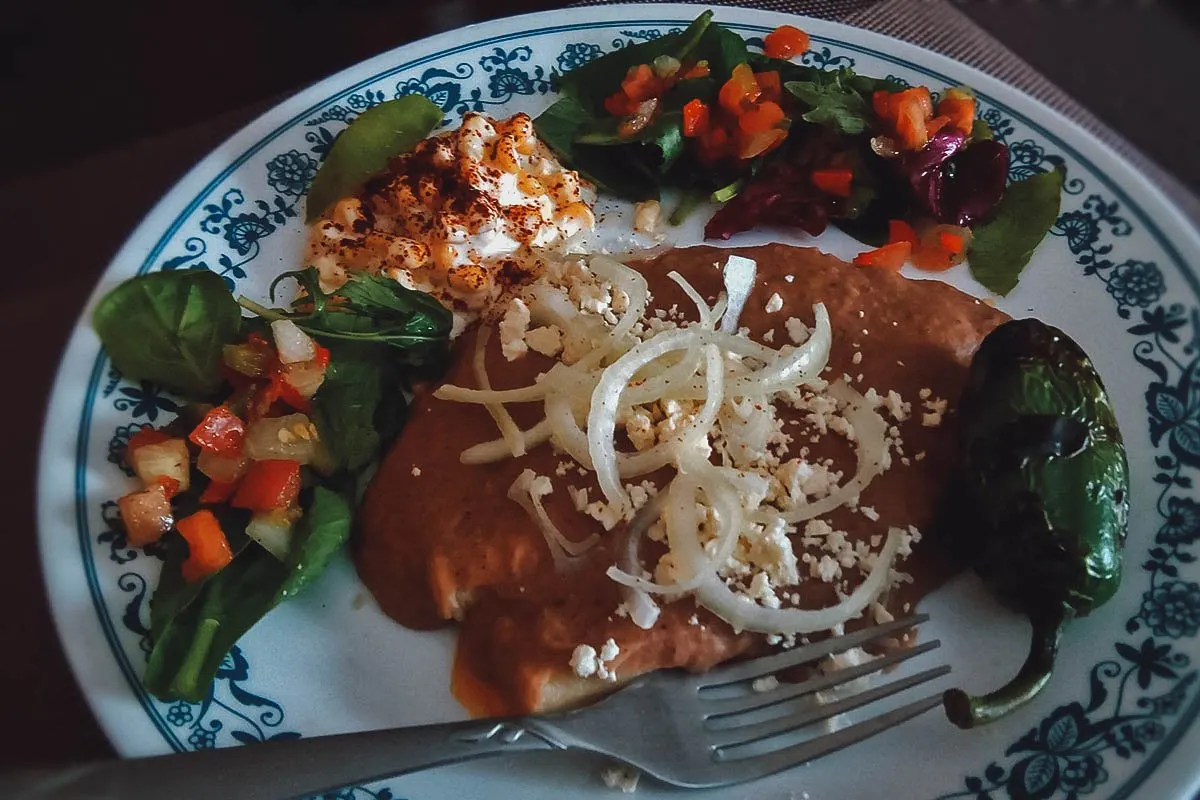
Enfrijoladas by goblinbox, used under CC BY 2.0 / Processed in Photoshop and Lightroom
Enmoladas
Can you guess what type of sauce enmoladas are made with? The term enmolada stems from the word mole and refers to any enchilada drenched in mole sauce. This version from a restaurant in Oaxaca was made with rich mole negro sauce and topped with a pair of sunny-side up eggs and queso fresco.
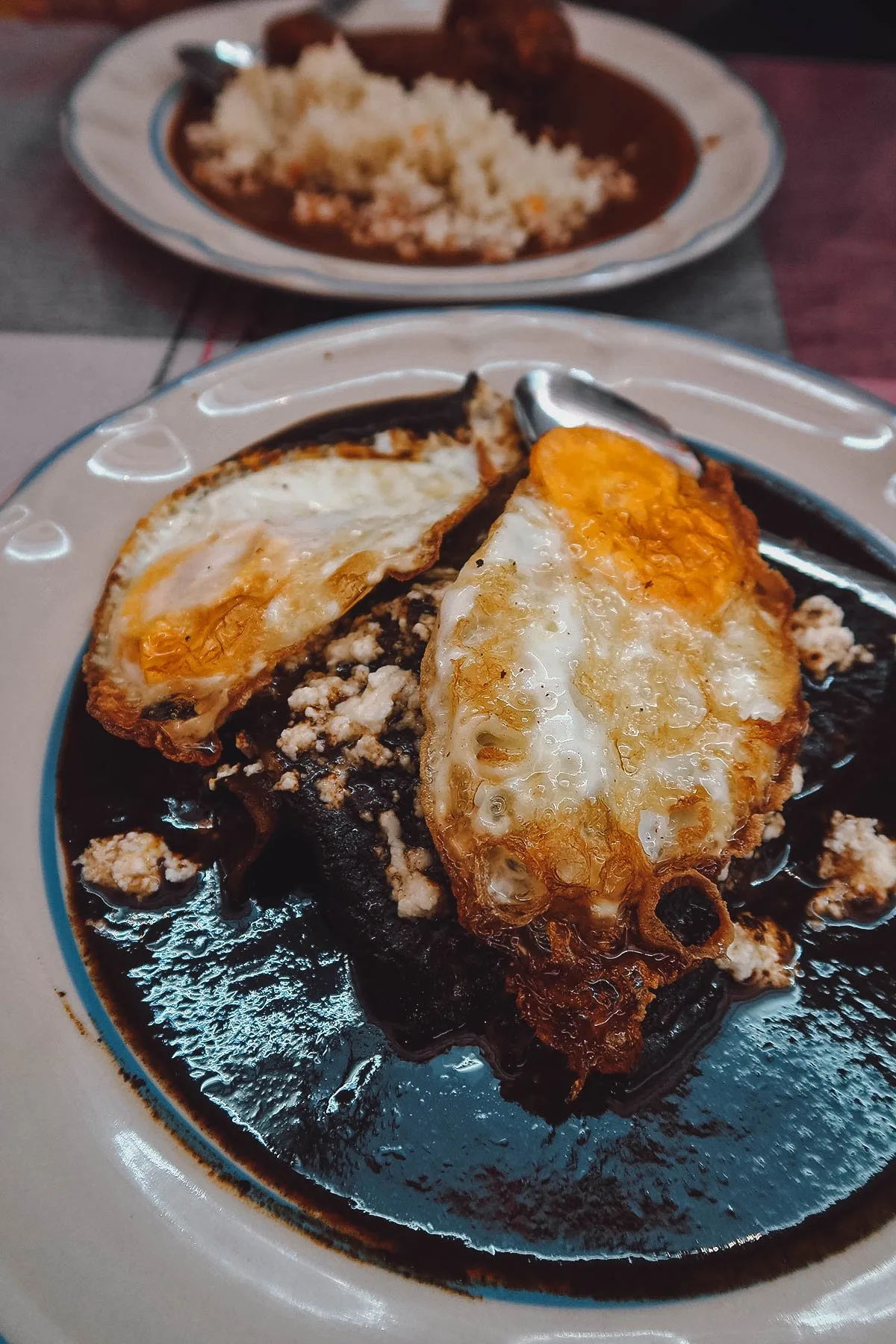
Enchiladas Mineras
These enchiladas mineras from a restaurant in Guanajuato are among the most delicious enchiladas we’ve had anywhere in Mexico.
Enchiladas mineras are a specialty of Guanajuato City, a former mining town in central Mexico. As you can probably guess from its name, it’s named after the people who used to work in those mines. Meaning “miner’s enchiladas”, the miners’ wives would make them this dish after a long day of working in the mines.
An enchilada minera consists of a rolled corn tortilla filled with cheese, onions, and a stew-like mix of potatoes and carrots. The enchiladas are baked and then served with grilled chicken, jalapeño peppers, cheese, lettuce, and salsa.
Guanajuato City isn’t known for having as many regional specialties but this is one dish that you absolutely cannot miss. It’s delicious.
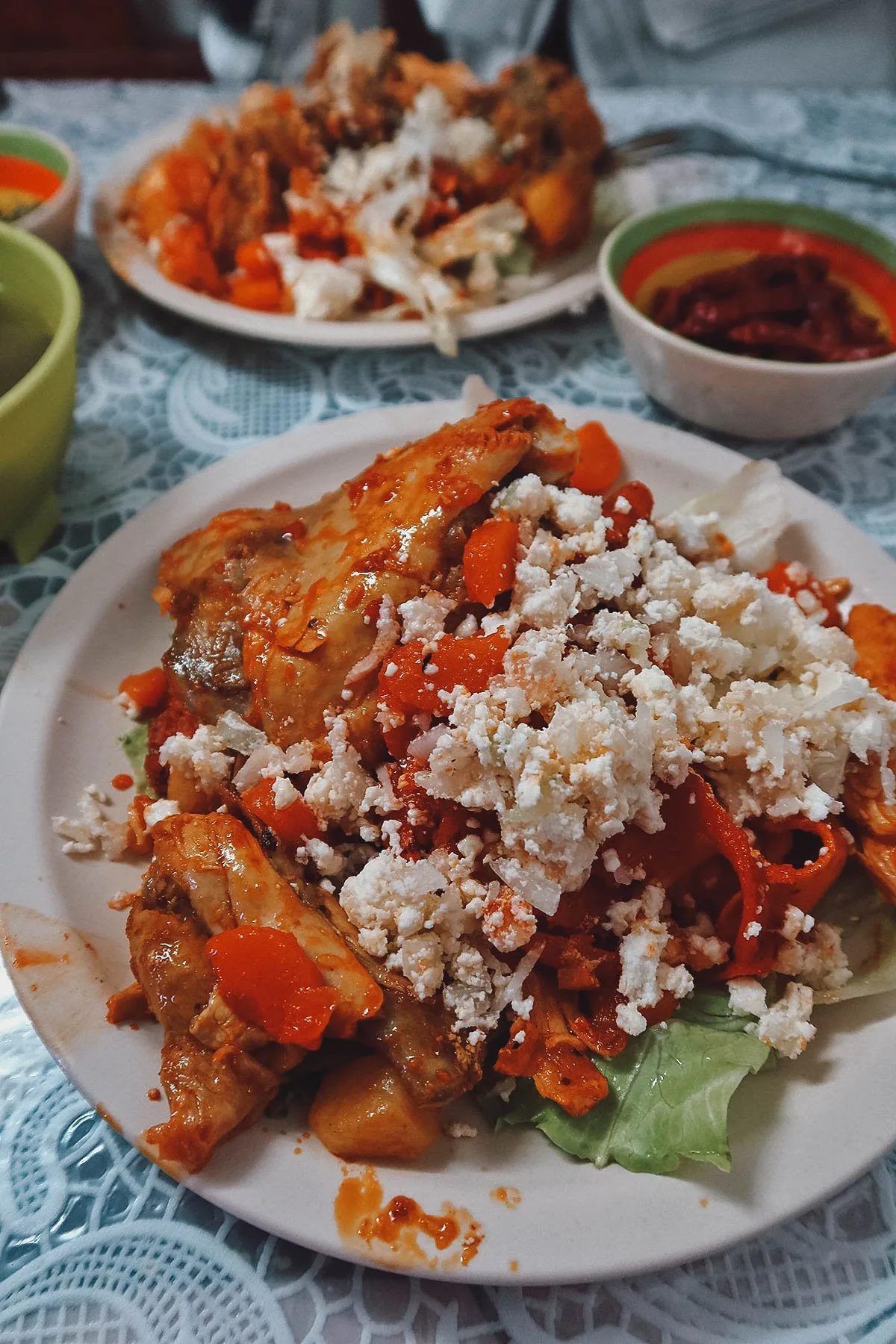
ANTOJITOS / STREET FOOD
Antojitos literally means “little cravings” and refers to a family of Mexican dishes typically enjoyed as street food or snacks. Traditionally sold by roadside vendors and at market stalls, typical antojitos include tacos, tortas, quesadillas, gorditas, chalupas, and memelas.
4. Tacos
No list of the most popular Mexican foods can ever be complete without mentioning the humble taco. It’s the most iconic and internationally recognizable Mexican dish.
When people in the US hear the word “taco”, they probably think of those crunchy deep-fried tortilla shells filled with ground beef, lettuce, tomatoes, sour cream, and hot sauce. I have yet to see that type of taco in Mexico.
In Mexico, authentic tacos are made with soft palm-sized corn tortillas topped with a variety of fillings like roasted meat, seafood, and Mexican stews. Unless you want them plain, they’re usually garnished with chopped onions, cilantro, lime juice, and chili sauce (red or green).
Tacos in Mexico are traditionally made with corn tortillas but some taquerias, perhaps to cater to American tourists, offer them with wheat (flour) tortillas as well. Tacos made with wheat tortillas are always more expensive.
You’ll find dozens of taco varieties in Mexico but listed below are some of the most common.
Tacos al Pastor
Tacos al pastor are perhaps the most famous of all Mexican tacos. It consists of a freshly made corn tortilla topped with thin slices of heavily-marinated spit-roasted pork, onions, cilantro, and grilled pineapple. It can be found throughout Mexico but its’ especially popular in Mexico City where it’s originally from.
If you’re familiar with Lebanese food, then you may be pleased to learn that tacos al pastor are descendants of the Lebanese shawarma. More on that in the tacos arabes section of this Mexican food guide.
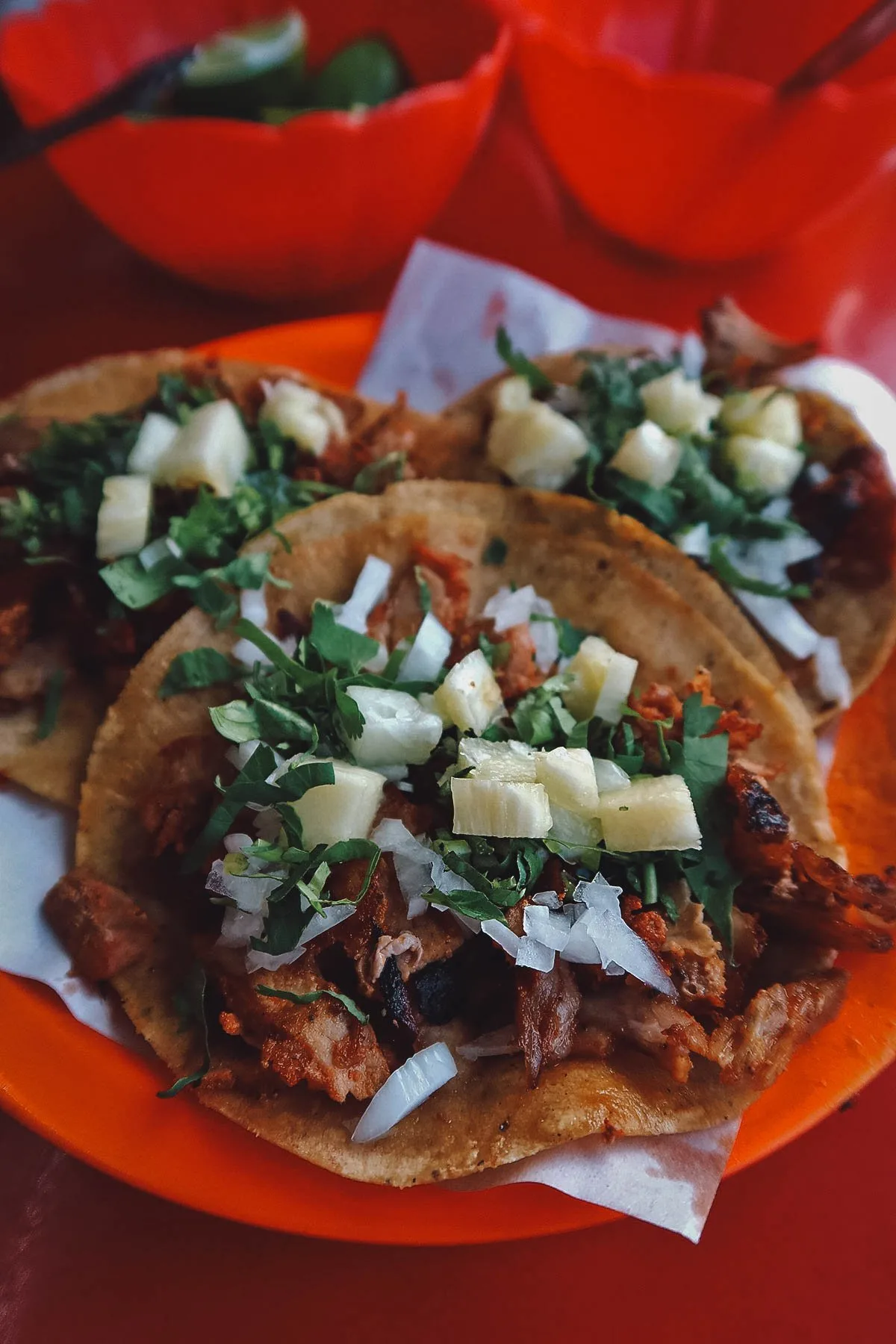
Tacos de Cabeza
Tacos de cabeza may not be for everyone but it’s personally my favorite type of taco in Mexico. Cabeza means “head” so tacos de cabeza refer to tacos filled with meat from the animal’s head like cachete (cheeks), lengua (tongue), ojo (eyes), seso (brain), and labio (lips).
The texture of head meat is quite different from regular cuts of beef or pork so I strongly advise anyone to try them at least once in Mexico. Tacos de cabeza, I labio. Sorry.
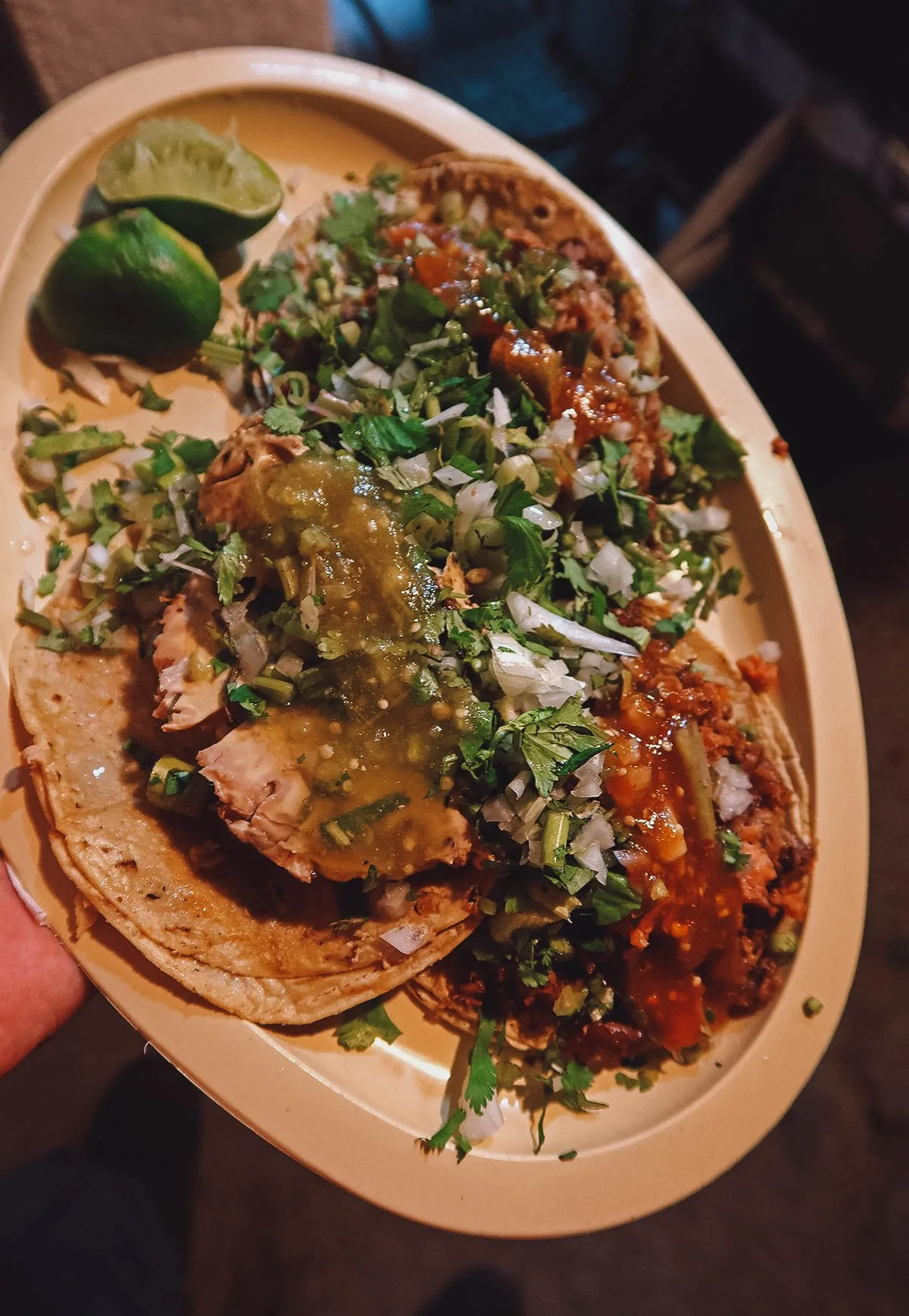
Tacos de Pescado / Camaron
If you’re from California, then tacos de pescado or camaron are no strangers to you. They’re tacos made with battered and fried fish or shrimp served with lettuce, pico de gallo, and a citrus/mayonnaise sour cream sauce.
If you aren’t an adventurous eater, then these will probably be your favorite tacos in Mexico. They’re especially popular in coastal cities like Cabo San Lucas, Puerto Vallarta, Playa del Carmen, Tulum, and Cancun.
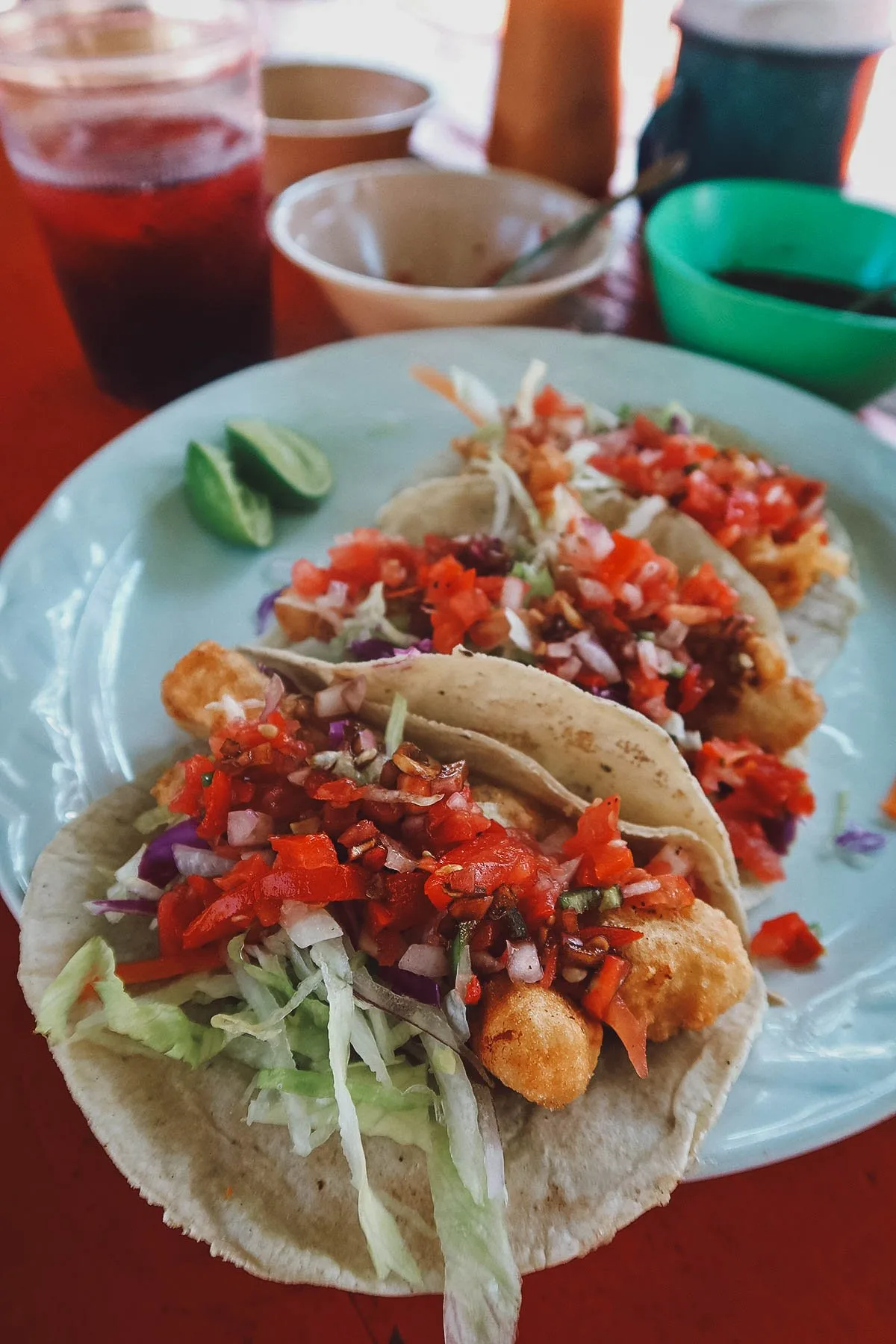
Tacos de Guisado
Like tacos al pastor, tacos de guisado are especially popular in Mexico City. Meaning “stew” in Spanish, a taco de guisado consists of a soft corn tortilla topped with a variety of stewed meats and vegetables.
The tasty pair of tacos de guisado below are topped with shrimp cake and stuffed chili pepper. They’re garnished with rice, black beans, and queso fresco.
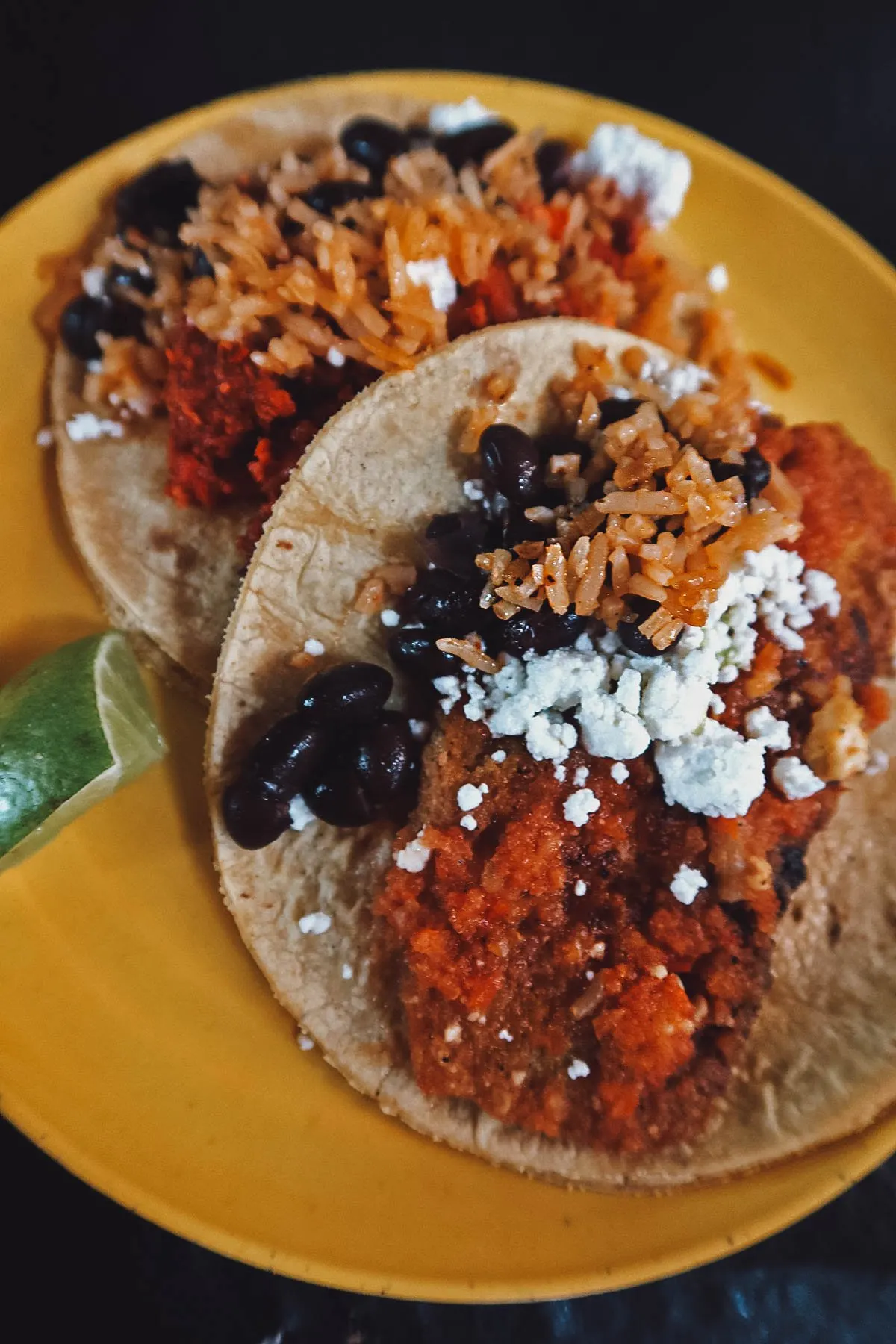
Tacos de Canasta
These are some of the most interesting tacos in Mexico. Tacos de canasta literally means “basket tacos” and refers to tacos that are filled with various stews and then bathed in melted butter or oil. They’re kept in baskets to keep them warm, hence the name tacos de canasta.
Tacos de canasta are among the cheapest if not the cheapest type of taco you can find in Mexico. I’ve enjoyed them for as low as MXN 4 apiece (about USD 0.20).
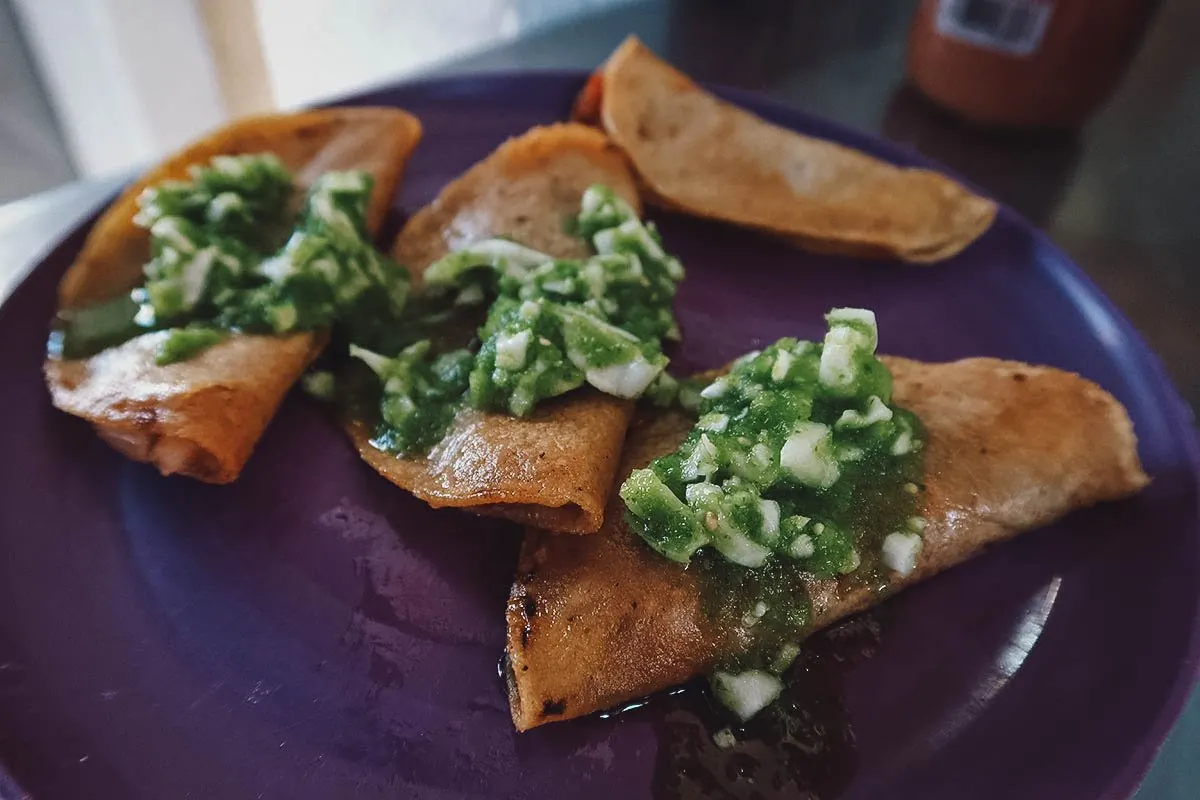
Tacos Arabes
Tacos arabes is the bridge between Lebanese shawarma and tacos al pastor. A specialty of Puebla, tacos arabes became a part of Mexican cuisine thanks to Lebanese and Syrian immigrants who migrated to Mexico sometime after the First World War.
Compared to tacos al pastor, the meat in tacos arabes is seasoned more simply. Instead of corn tortillas, it’s traditionally rolled in pita bread (pan arabe) and served without any garnishes. To eat, just give it a spritz of lime juice and sauce, usually green or red salsa.
Pictured below are two tacos arabes and one taco oriental from a restaurant in Puebla. Tacos orientales are basically the same thing as tacos arabes except the meat is wrapped in corn tortillas so they’re much smaller.
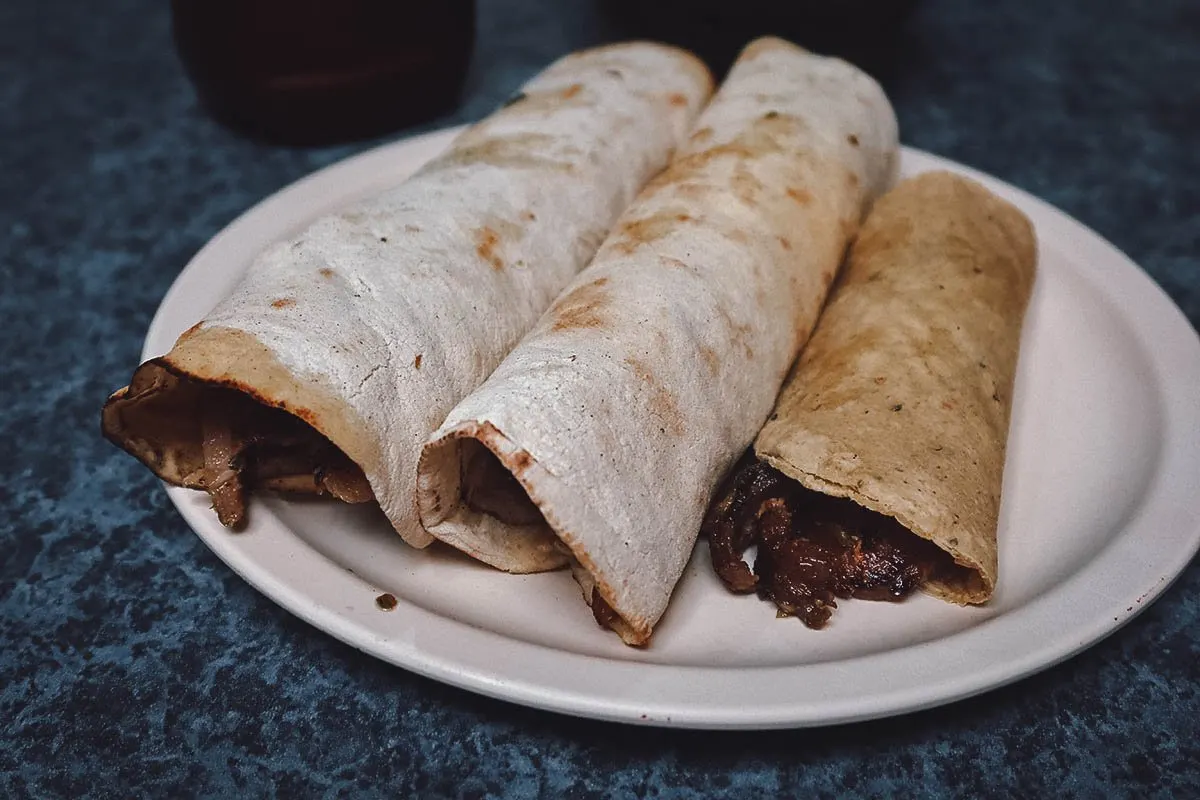
5. Quesadilla
Quesadillas are among the most popular Mexican foods outside of Mexico. It’s basically the same thing as a taco except it’s bigger and filled with a soft melty cheese. Like tacos, quesadillas are traditionally made with corn tortillas but they can be made with flour tortillas as well.
If you look at a taqueria’s menu, it’ll usually list the types of meat they have like al pastor, chorizo, chuleta (pork chop), or arrachera (beef steak). Many taquerias can serve these meats in tacos, quesadillas, or tortas (sandwiches).
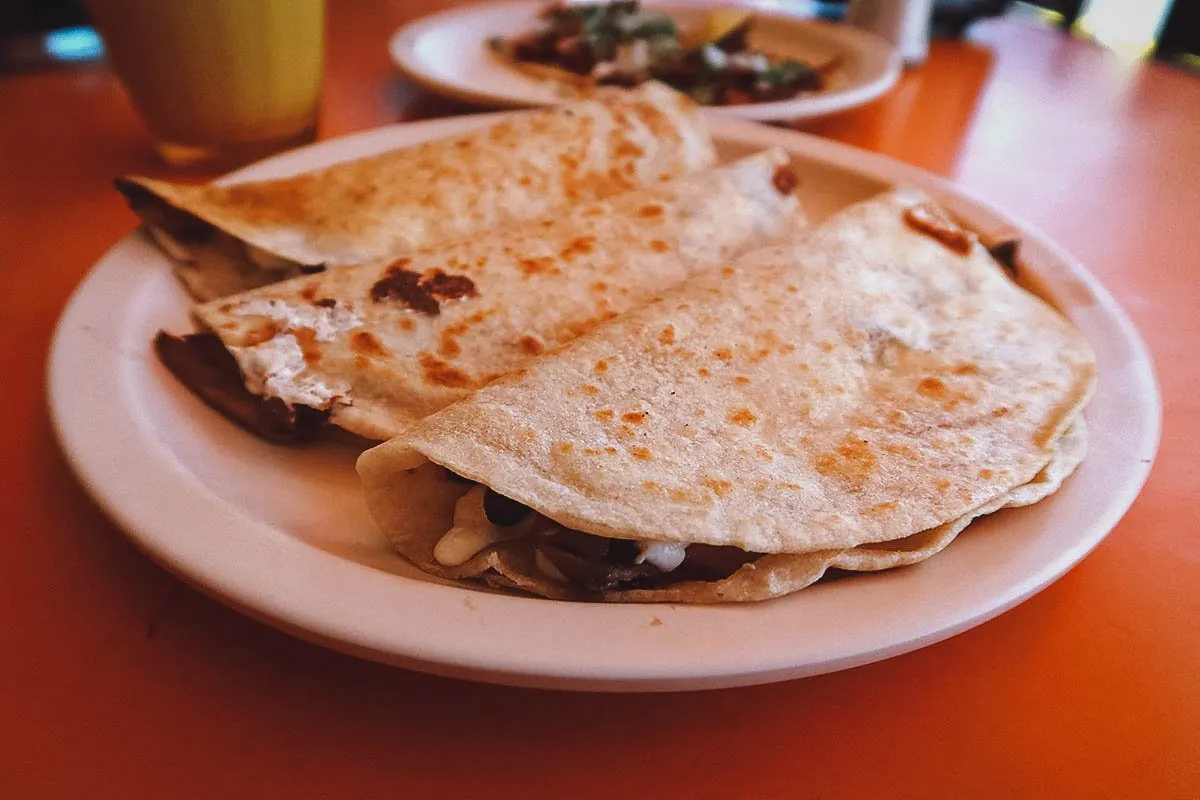
6. Salbutes / Panuchos
The Yucatan is home to some of the most interesting food in Mexico. It’s a combination of traditional Mayan food infused with foreign influences. Cochinita pibil, lechon al horno, and relleno negro are some of its most popular dishes and one of the best ways to have them is on salbutes and panuchos.
Salbutes and panuchos are puffy, fried corn tortillas that can be topped with any number of ingredients. It’s basically a Yucatecan variation of the taco. The only difference between salbutes and panuchos is that the latter is stuffed with refried beans and tends to be a little crunchier in texture.
Pictured below is a trio of salbutes and panuchos from a restaurant in Merida. They’re topped with cochinita pibil, lechon al horno, and lomitos de Valladolid.
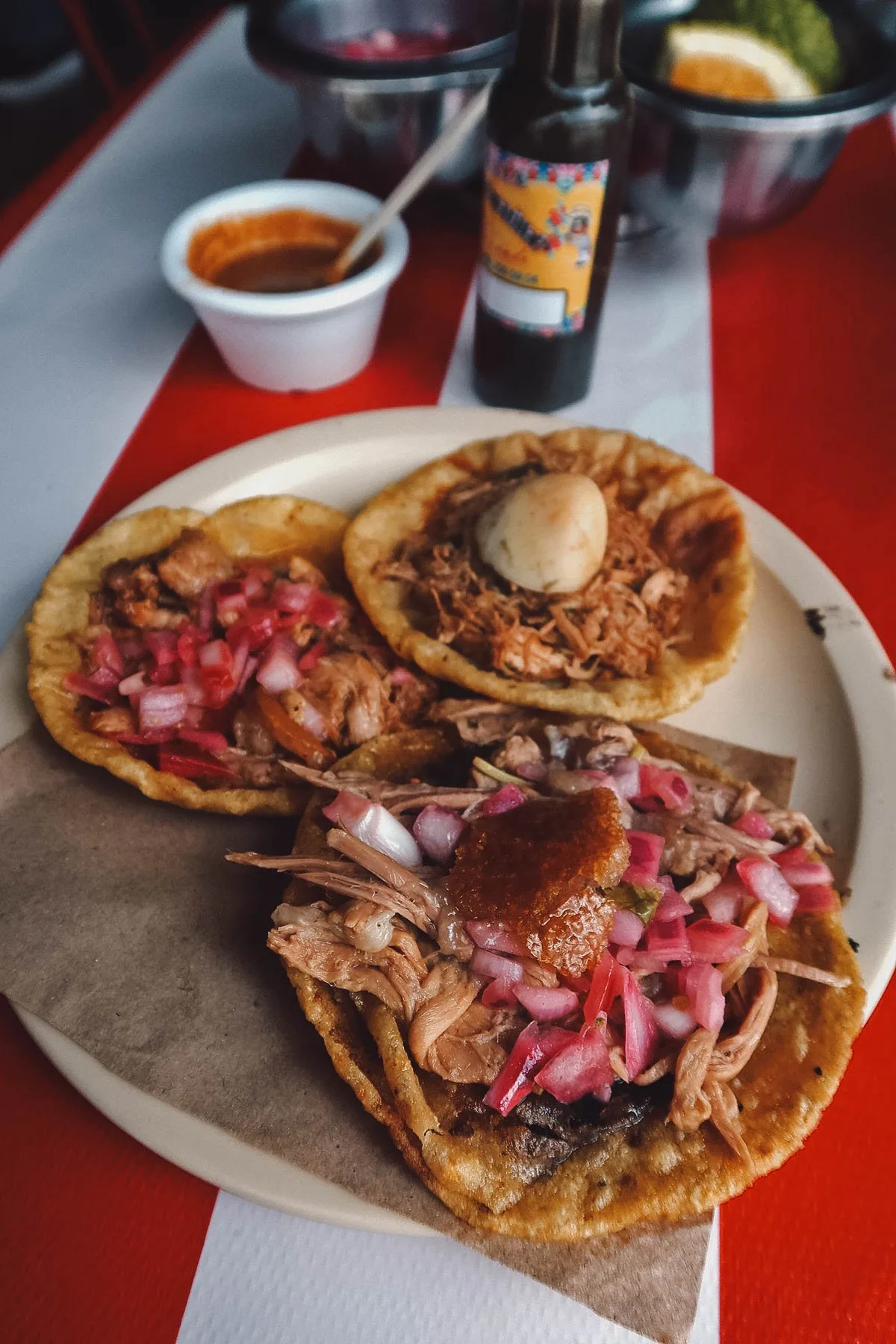
7. Tlacoyo
When people think of pre-Hispanic food, the first dish that usually comes to mind is tamales. Tamales are tasty but you should also look for tlacoyo, a traditional Mexican dish that’s existed for thousands of years.
A popular street snack in Mexico City, tlacoyos are oval-shaped corn masa snacks stuffed with a variety of ingredients like beans, cheese, chicharron, and vegetables. It’s an interesting Mexican dish that’s probably not as easy to come by outside of Mexico.
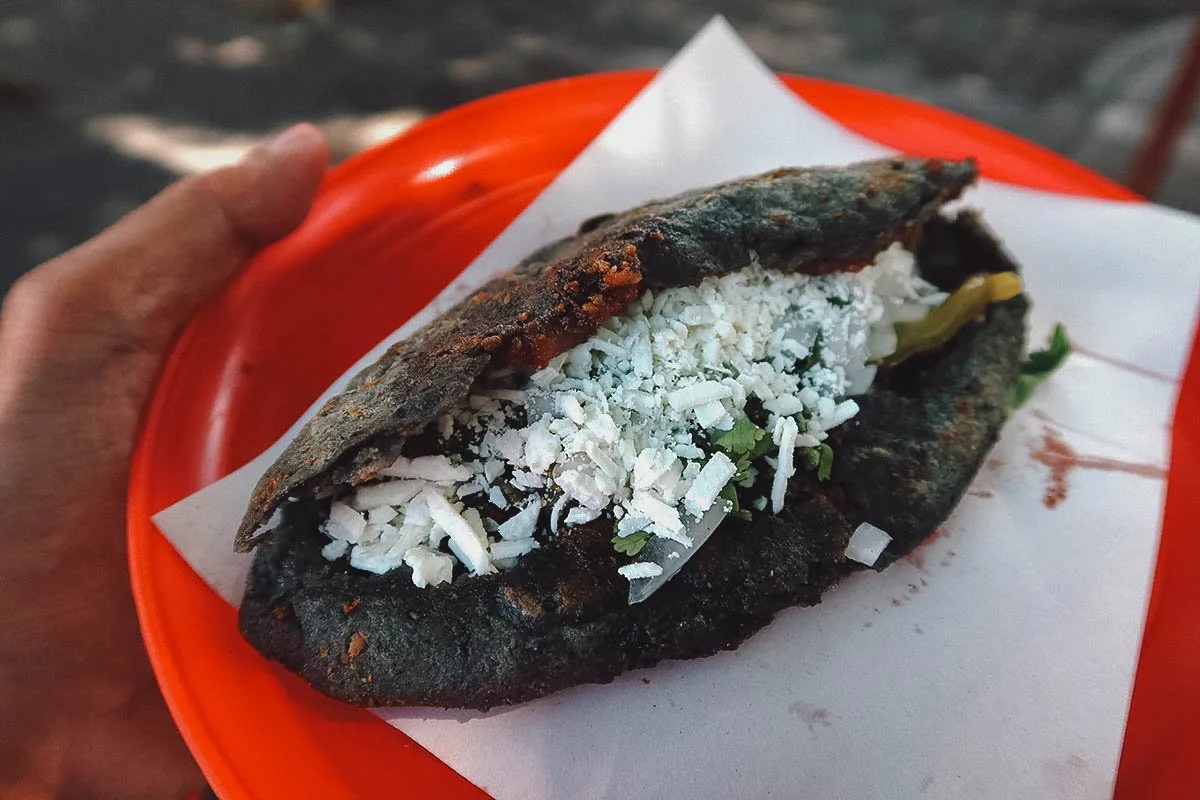
8. Tamales
As described, the tamal is perhaps the most well-known pre-Hispanic dish not just in Mexico, but in all of Latin America. It consists of masa corn dough steamed in corn husk or banana leaves. It exists in many varieties throughout Mexico and can be enjoyed plain or stuffed with a variety of ingredients like meat, cheese, mole, herbs, and vegetables.
In Oaxaca, we had a terrific version enriched with mole negro, but the tastiest tamal I’ve had so far in Mexico is this incredibly delicious tamal colado from Merida. It’s a Yucatecan version of tamales made with strained corn dough. Straining the masa results in a softer, much more delicate type of tamal.
Personally, I’m not that fond of tamales but this one made me a fan. You seriously need to try it if you visit the Yucatan Peninsula.
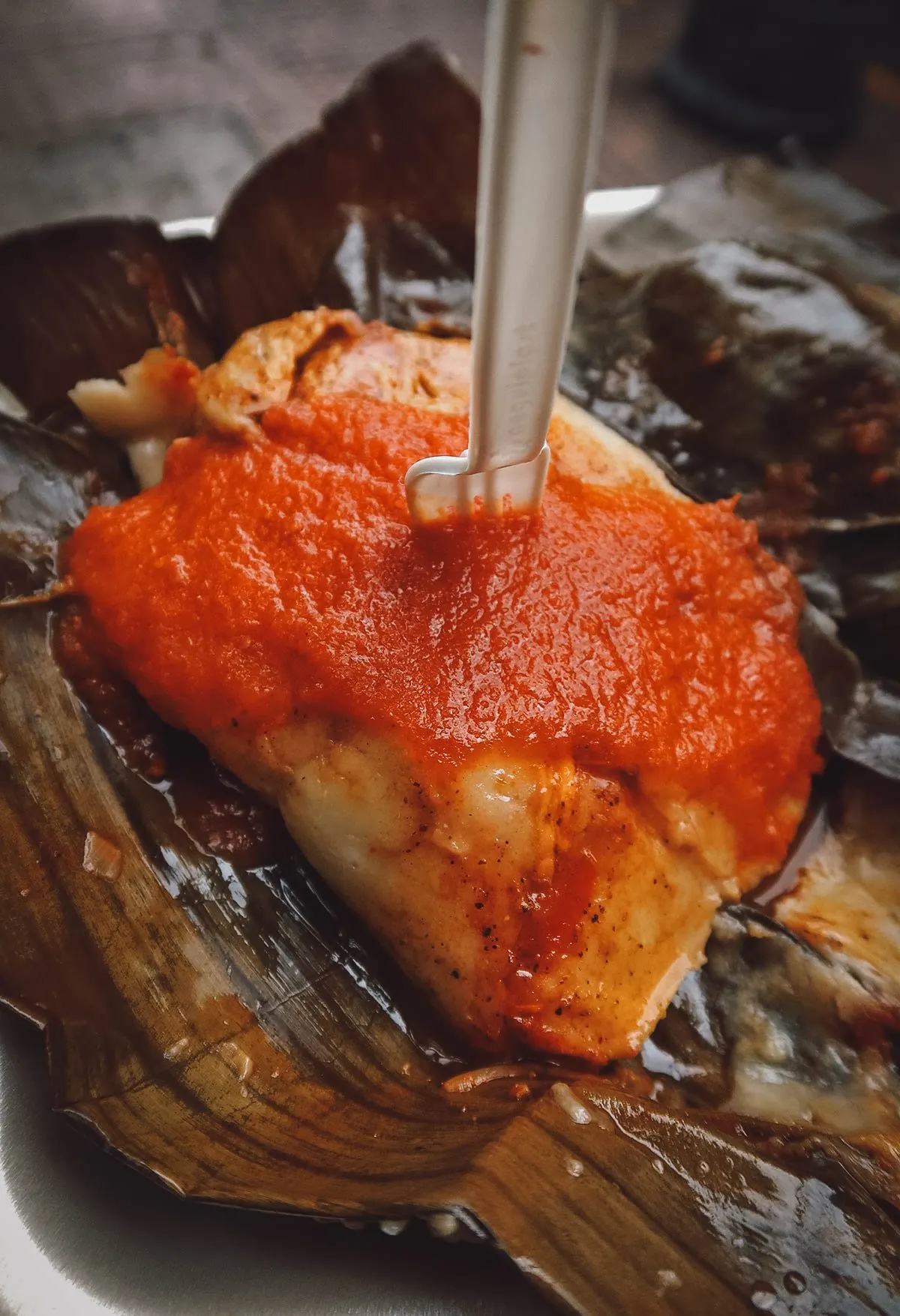
Guajolota
If you like tamales and are spending time in the Mexican capital, then guajolota is another dish you should look for. A popular street food dish in CDMX, it’s basically a tamal sandwich that’s commonly eaten for breakfast with atole.
Atole is a hot corn and masa beverage sweetened with piloncillo (unrefined whole cane sugar), vanilla, and cinnamon.
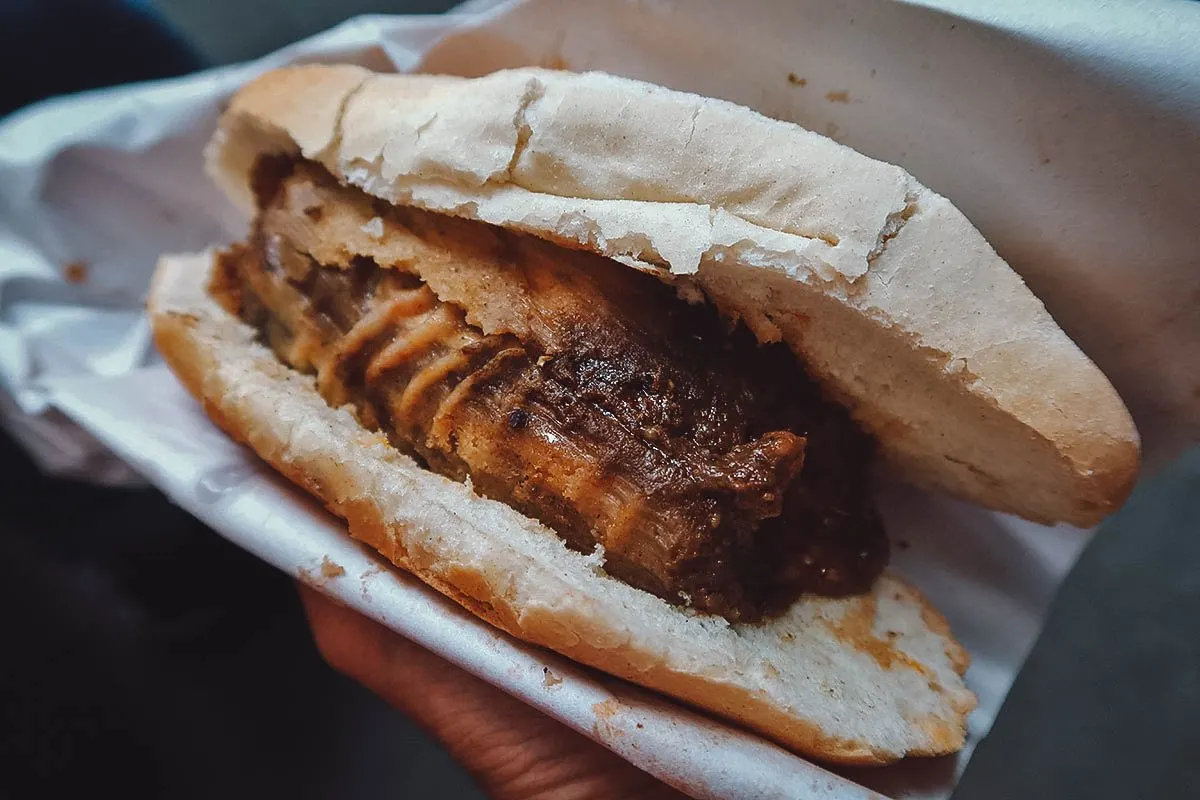
9. Torta
Torta refers to any type of sandwich in Mexico. The guajolota above is one type of torta. Depending on where you go in Mexico, you can find tortas that are specific to that city or region. Listed below are some of the best Mexican tortas we’ve tried so far.
Tortas Ahogadas
If you visit Guadalajara, there are two local dishes that you absolutely must try – birria and tortas ahogadas. Meaning “drowned sandwich”, tortas ahogadas are meat-filled submarine sandwiches drenched – and I mean DRENCHED – in a spicy tomato- or chili-based sauce.
Tortas ahogadas are so soppingly wet that you basically need to eat them with a spoon. They’re messy but delicious and oh so worth it.
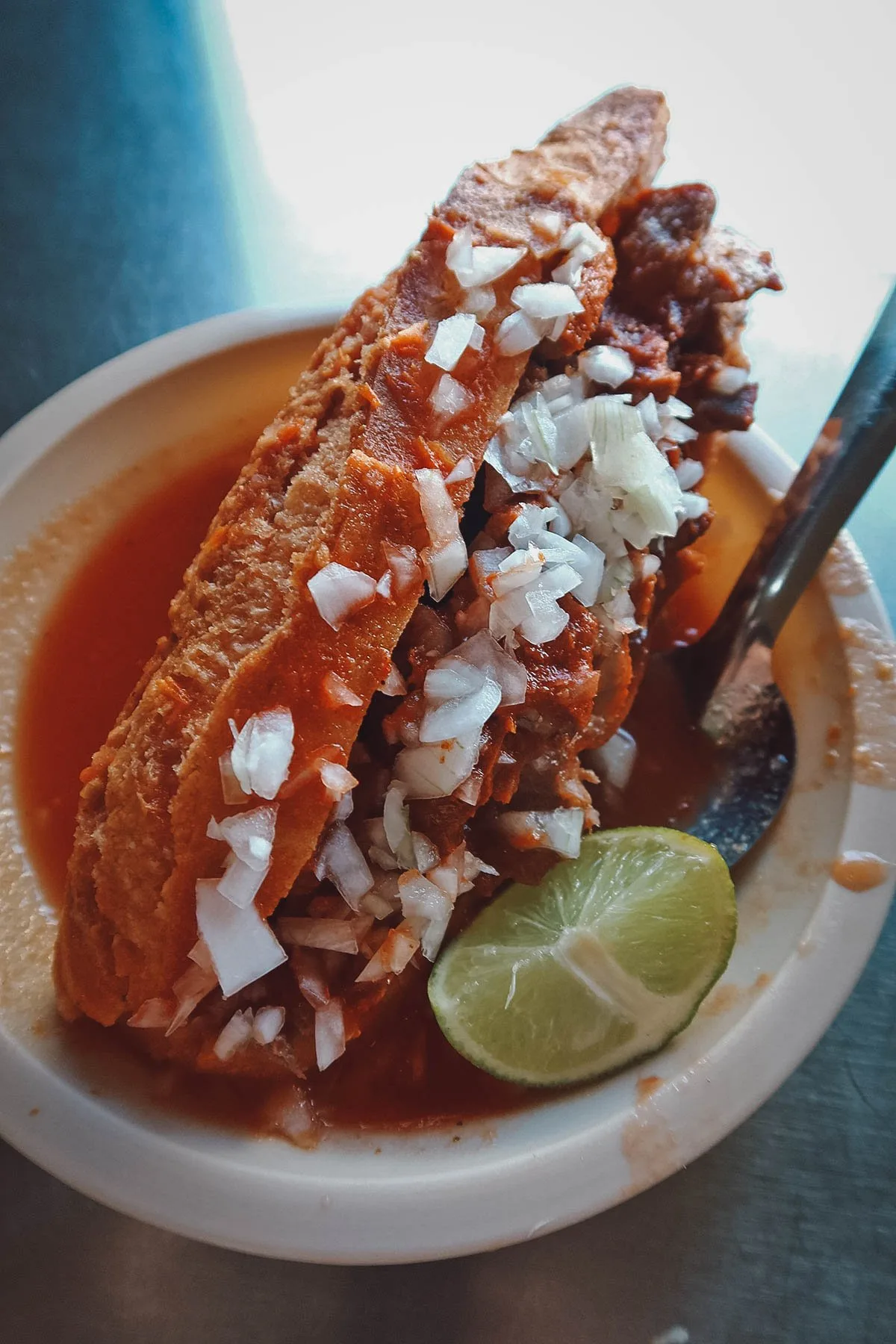
Cemita
I absolutely love sandwiches and Pueblan cemitas are among my favorite sandwiches in the world. If tacos are king in the Mexican capital, in Puebla, it’s cemitas. The term cemita can refer to both the sandwich and the sesame-covered bread roll it’s made with.
Cemitas in Puebla can be made with different fillings but traditionally, a classic cemita poblana is made with chicken or pork milanesa, quesillo (Oaxacan cheese), avocado, pápalo, onions, and chili peppers – either chipotle adobado or rajas (roasted poblano peppers).
Let me just say that there are no superfluous ingredients in this sandwich. Every component does its part in the construction of what could very well be the perfect Mexican sandwich. It’s so damn good and something I ate almost everyday in Puebla.
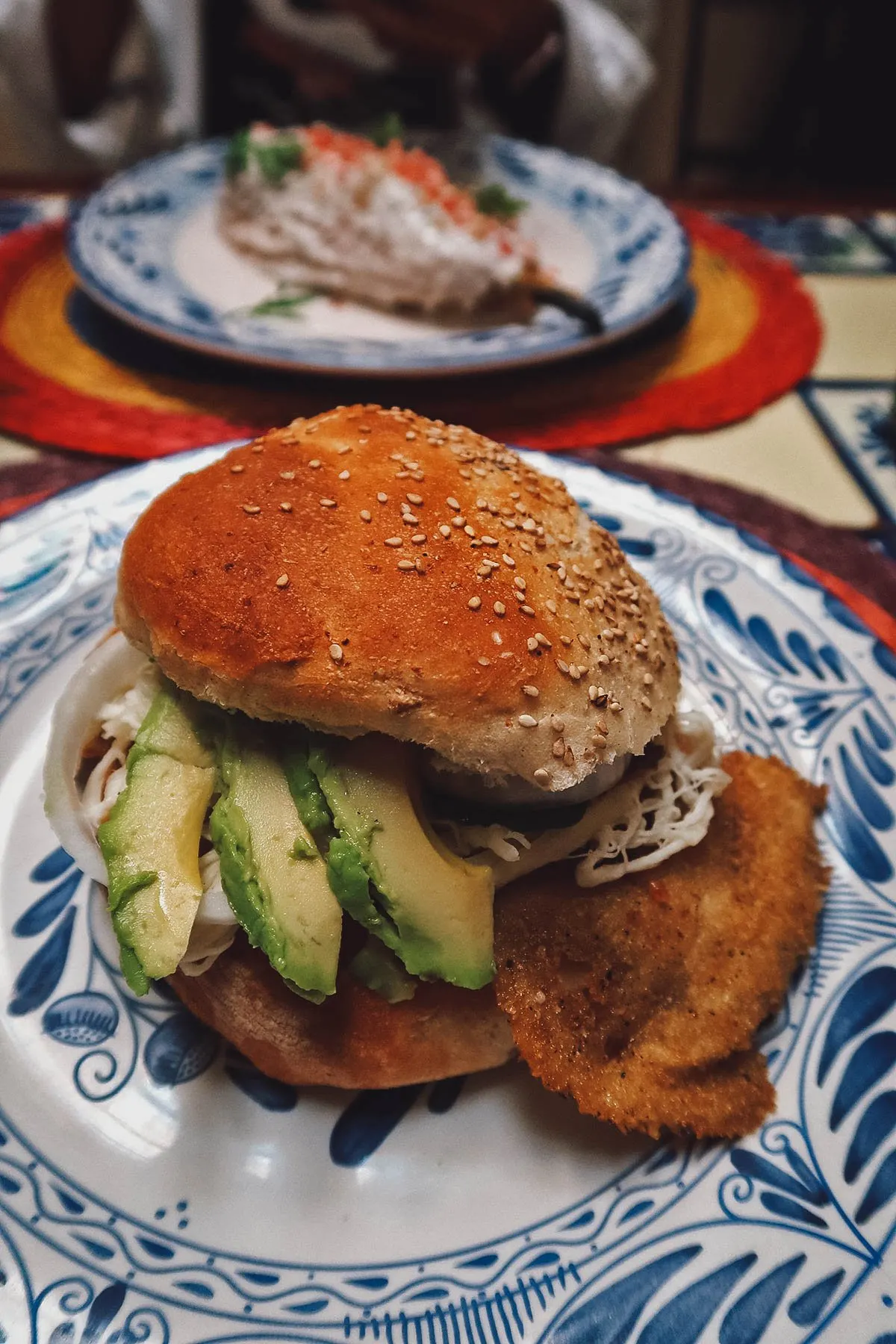
Pelona
Pelonas are another sandwich that you need to try in Puebla. Unlike cemitas which can be made with different fillings, pelonas are made with a specific set of ingredients – shredded beef, refried beans, lettuce, and salsa.
What makes this Pueblan sandwich truly special is that it’s served on a crunchy fried bread roll.
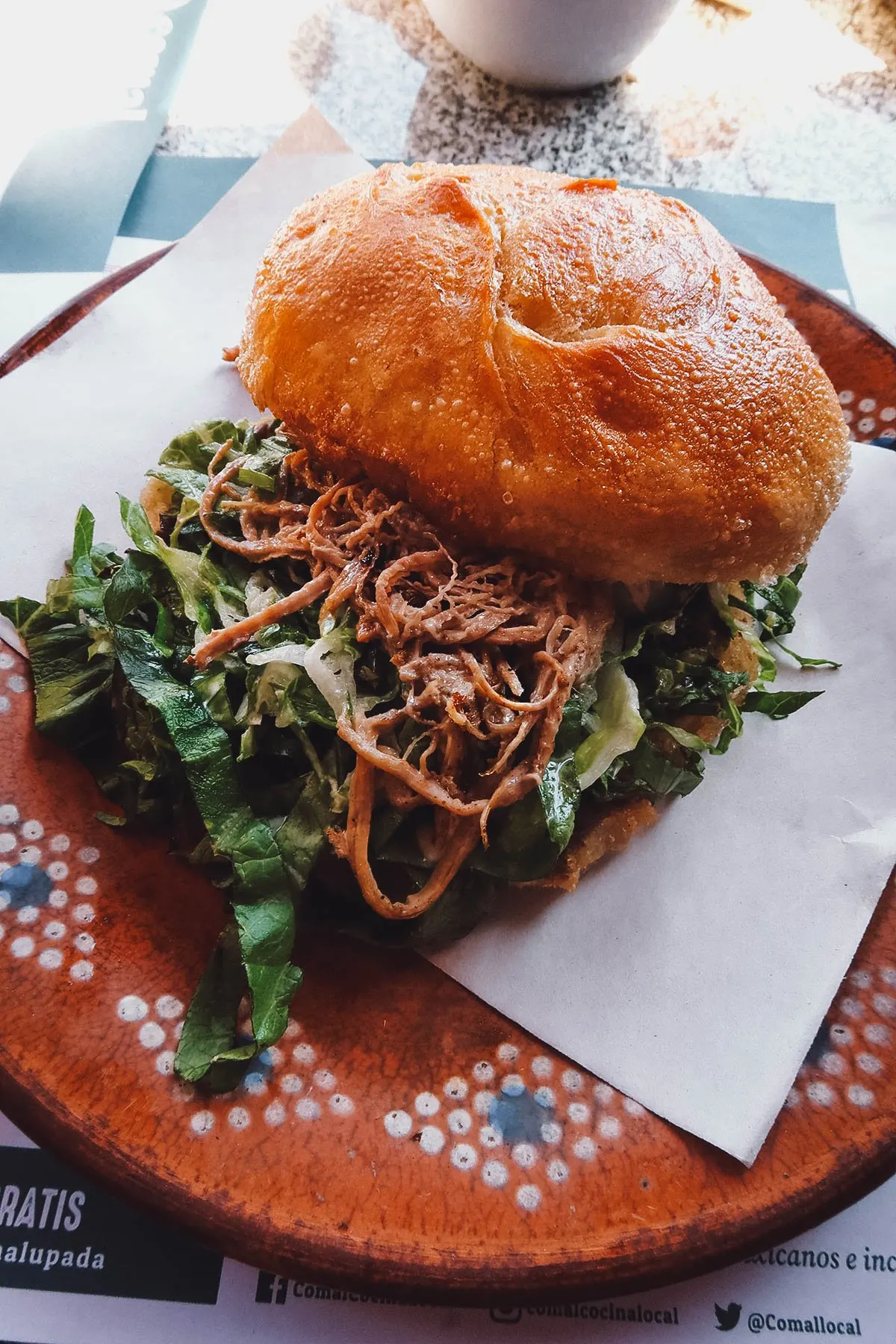
Guacamaya
If you ever visit León or Guanajuato City, then you need to try this beast of a sandwich called the guacamaya. Originally from León, it’s basically an open-faced sandwich made with a bolillo bread roll stuffed with roast pork, shards of chicharron, avocado, lime juice, and salsa.
This picture doesn’t even do the guacamaya justice. You need to see it to appreciate just how big and loaded this beautiful Mexican sandwich really is.
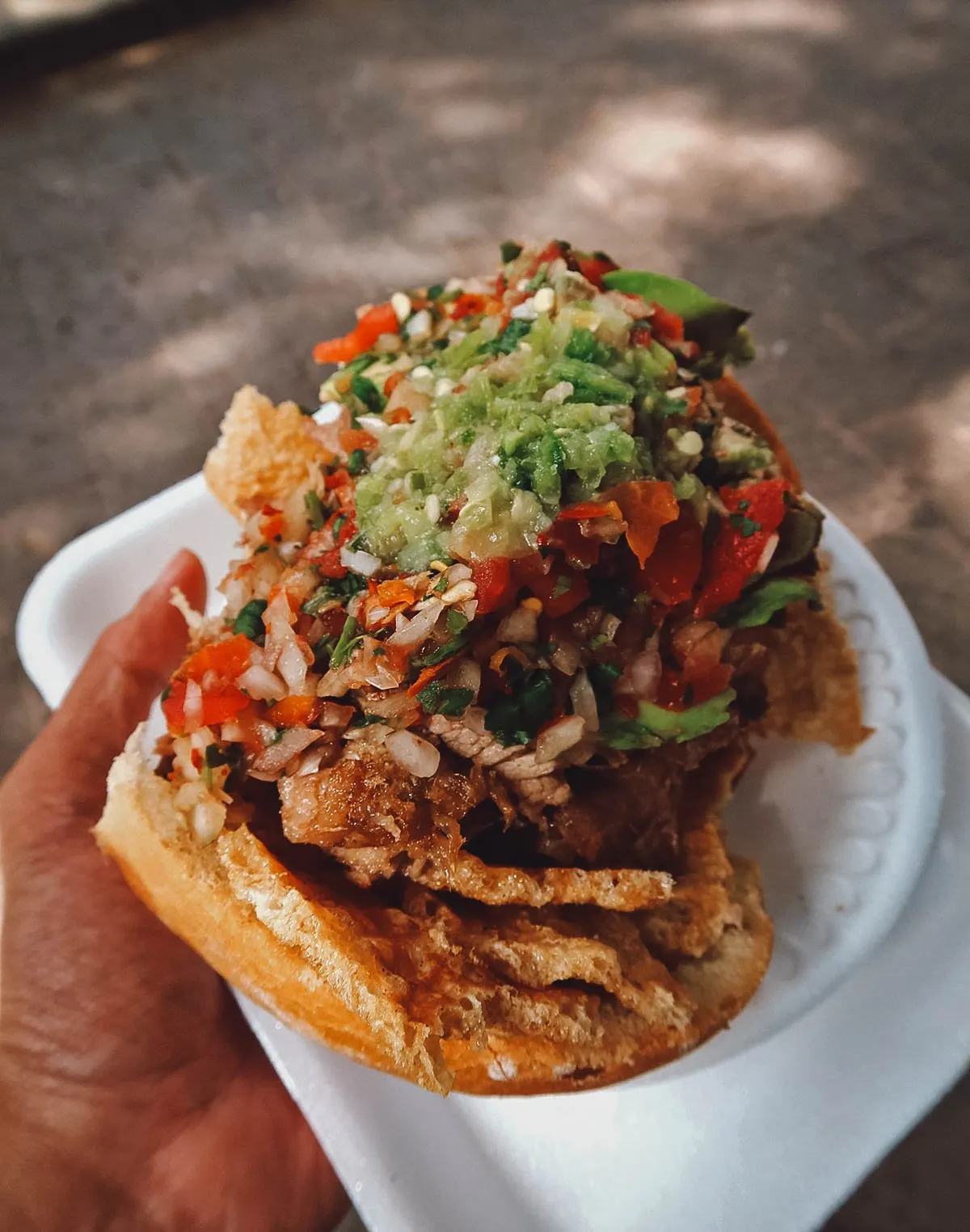
10. Elotes / Esquites
Corn is the most important ingredient in many Mexican recipes so it’s no surprise that elotes and esquites are among the most popular street foods in Mexico. They’re very similar dishes prepared in slightly different ways.
Pictured below is an elote. It’s basically boiled corn on the cob slathered with butter, mayonnaise, garlic, chili powder, Cotija cheese, and lime juice. It’s simple and very messy to eat but oh so delicious.
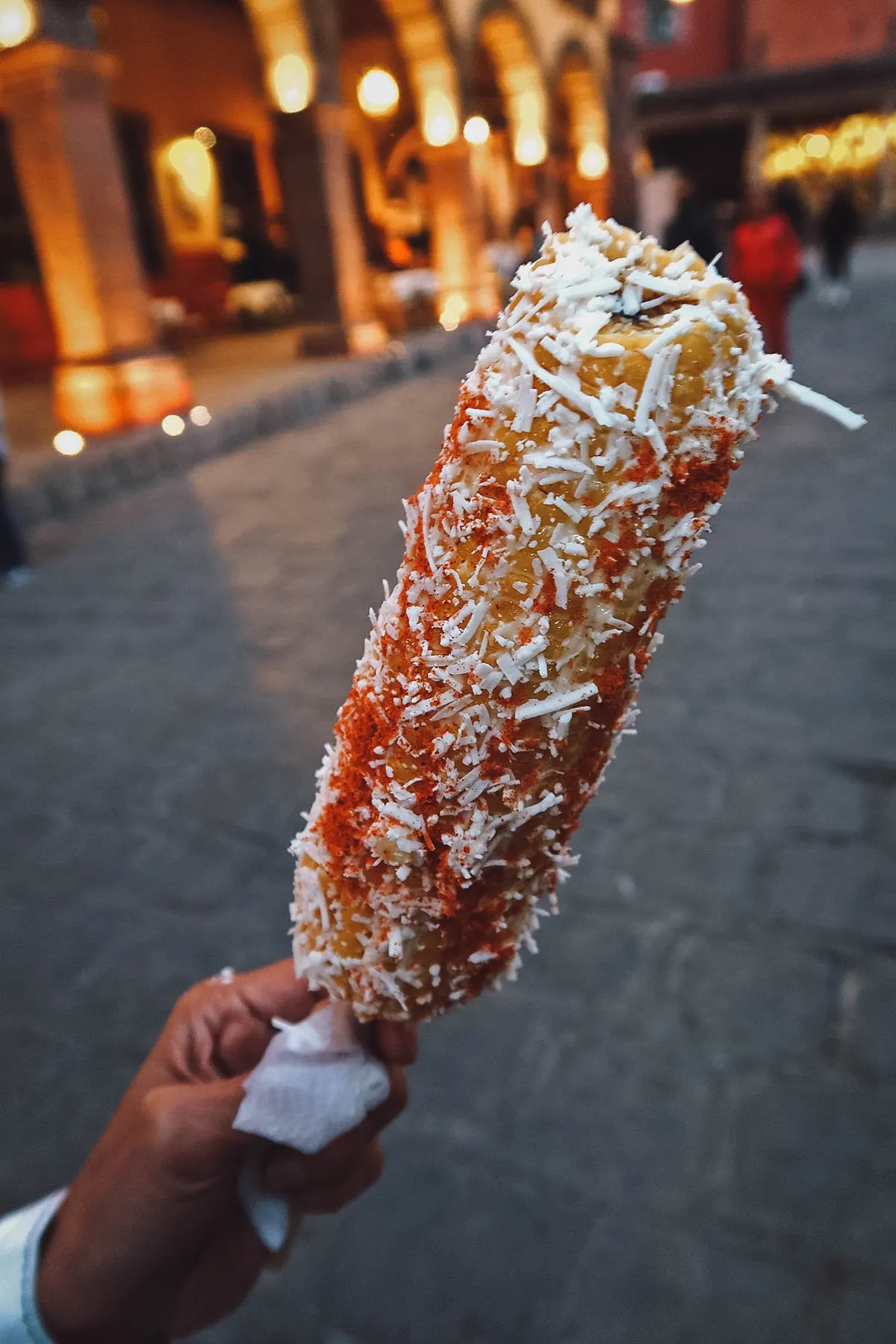
Esquites are very similar to elotes except the corn kernels are shaved off the cob and served in a cup. Check out this gorgeous spoonful of corn, Cotija cheese, chili powder, and lemon juice.
Personally, I enjoy elotes more but if you don’t like messy food, then it’s probably best to go with esquites. Pretty much every roadside vendor I’ve seen that sells elotes will also have esquites.
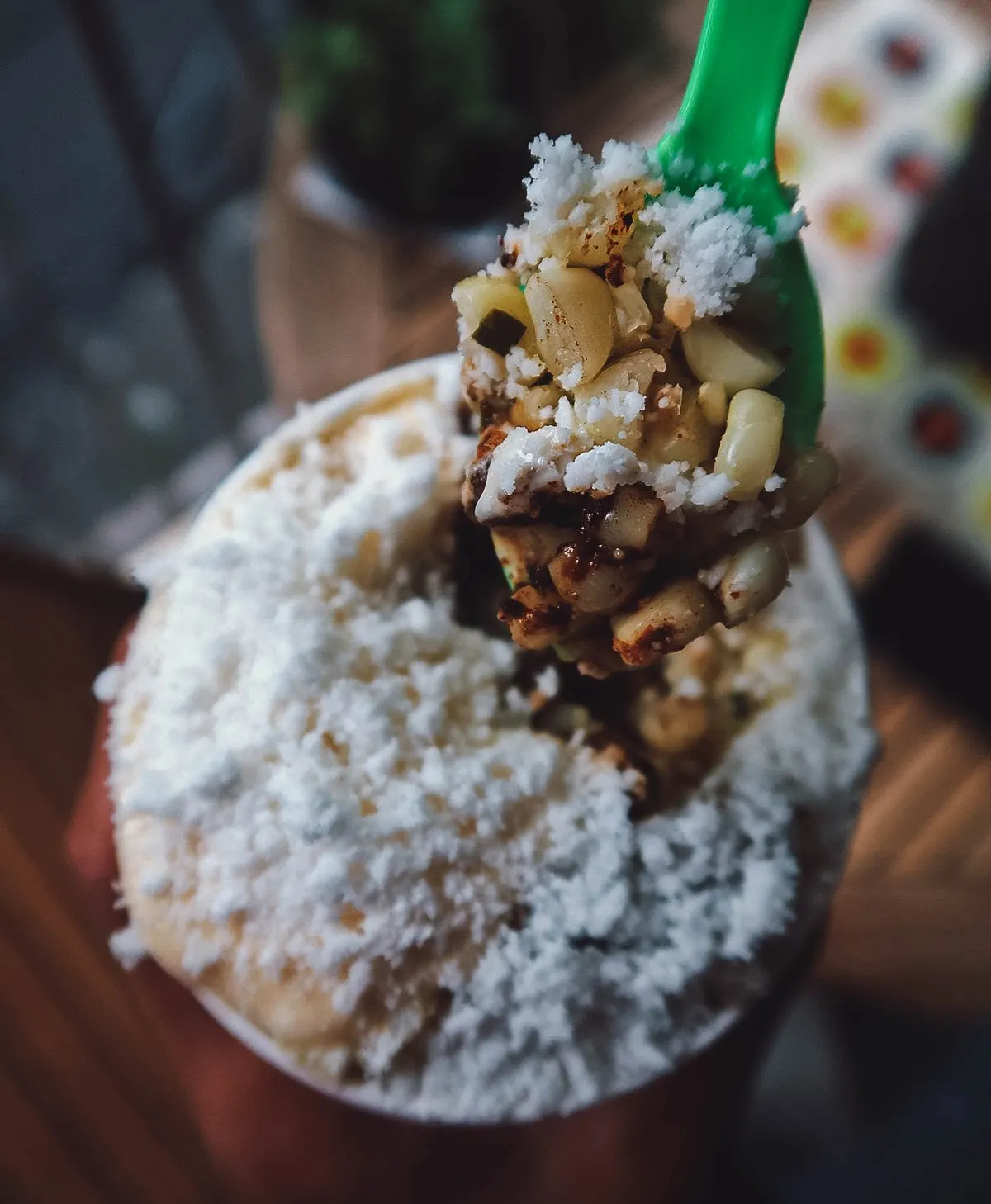
11. Tlayuda
Oaxaca is known for having some of the best food in Mexico and tlayudas are among the tastiest dishes you can try there. It refers to a large, partially fried or toasted tortilla topped with refried beans, asiento (unrefined pork lard), quesillo, and other ingredients like shredded lettuce, avocado slices, and roasted meats.
Tlayuda is a popular street food in Oaxaca and sometimes described as a form of Mexican pizza. It can be served open-faced, like a regular pizza, or folded in half like below. Some stalls or restaurants will serve it with pipicha, a cilantro-like herb often used in Mexican cuisine.
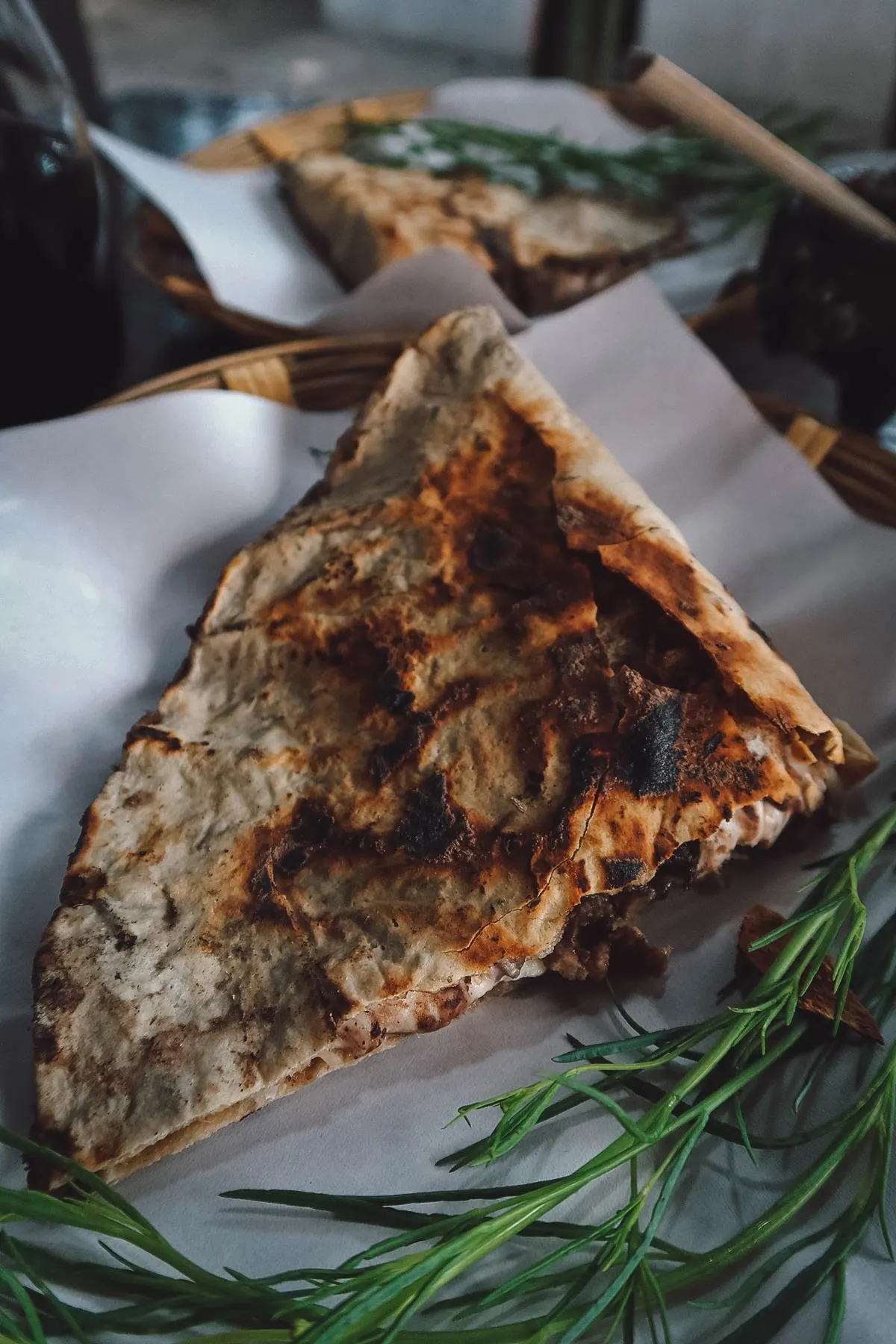
12. Memela
Memelas are another popular street snack that you need to try in Oaxaca. It refers to round or oval-shaped discs of toasted masa topped with refried beans and a variety of other ingredients like tinga (shredded chicken stew), chicharron, fried eggs, queso fresco, and guacamole. It can be eaten for breakfast, as an appetizer, or as a midday snack.
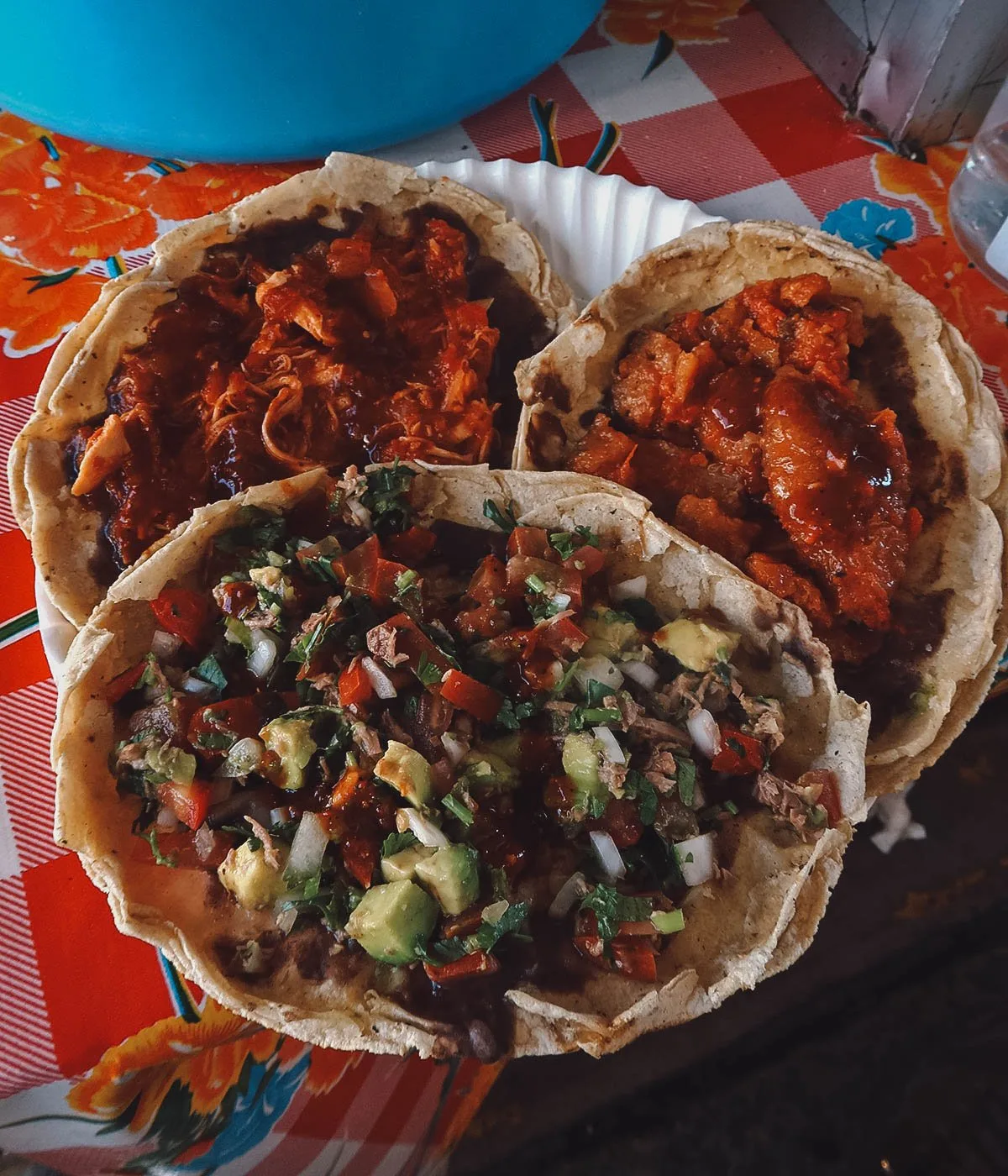
13. Chalupa
If Oaxaca has memelas, then Puebla has chalupas. Chalupas are about the same size as memelas but instead of being toasted on a comal (flat Mexican griddle), the corn tortillas are fried in oil.
Chalupas are usually topped with red or green salsa but you can find versions made with mole poblano as well. They’re almost always topped with shredded chicken or pork and chopped onions.
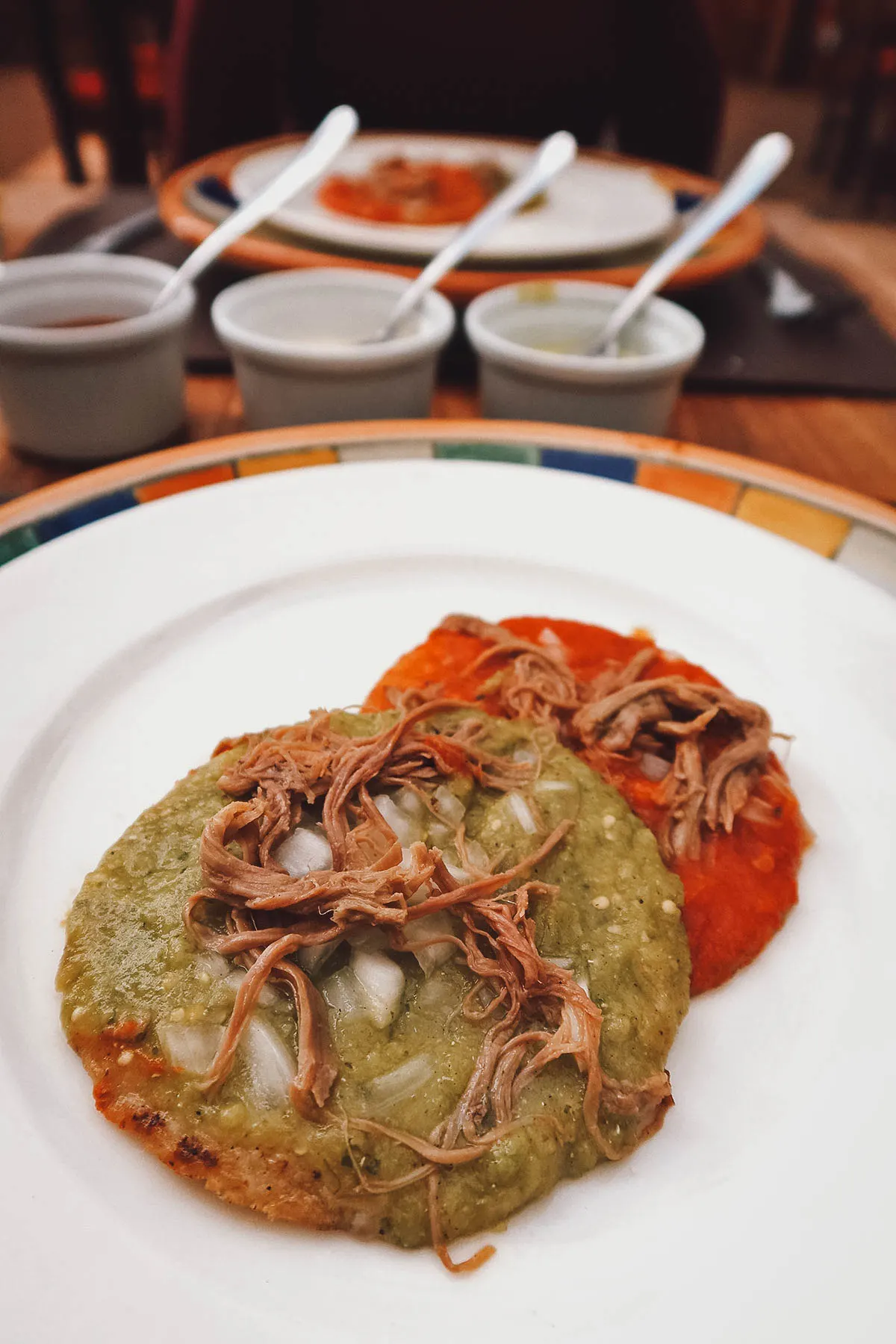
14. Empanada
The empanada is a hugely popular snack that’s consumed in many former Spanish colonies like Mexico, Chile, Venezuela, Colombia, Argentina, Peru, and the Philippines. Originally from Spain, its name stems from the word empanar which means “to bread” or “to wrap something in bread”.
Empanadas are half-moon-shaped turnover pastries that can vary greatly in size. They can be fried or baked and filled with a multitude of different ingredients like meat, peas, mashed potato, tomato, hard-boiled egg, raisins, and cheese.
This large baked empanada from Guanajuato was filled with mole rojo and pollo deshebrado (shredded chicken). Delicious!
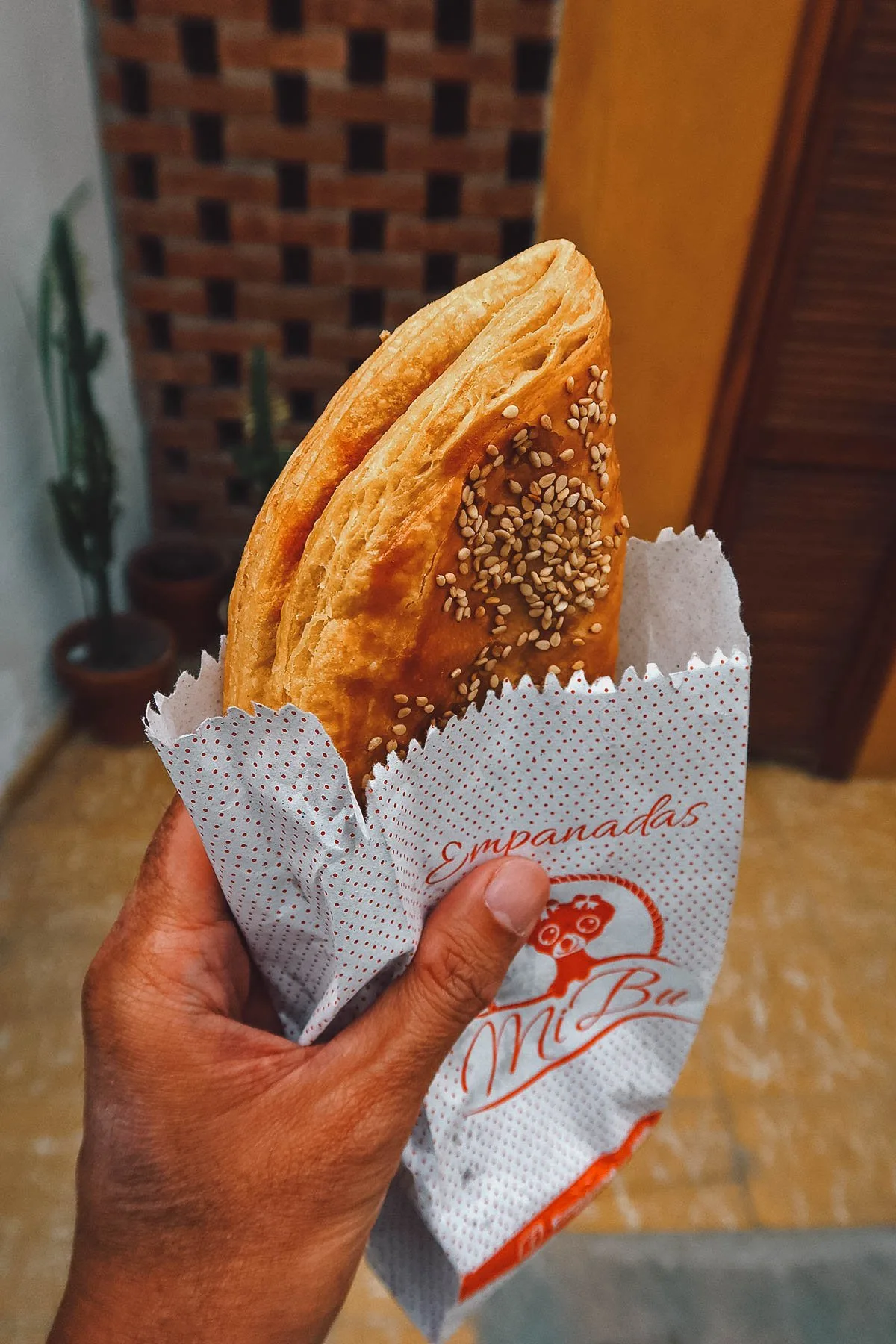
Empanada de Amarillo
Empanada de amarillo is another specialty dish from Oaxaca. Unlike most empanadas which are typically pinched shut, this version looks more like a quesadilla.
Empanadas de amarillo are made with a large corn tortilla toasted on a comal. It’s then filled with a specific set of ingredients – mole amarillo (yellow mole) and shredded chicken – before being folded in half and served.
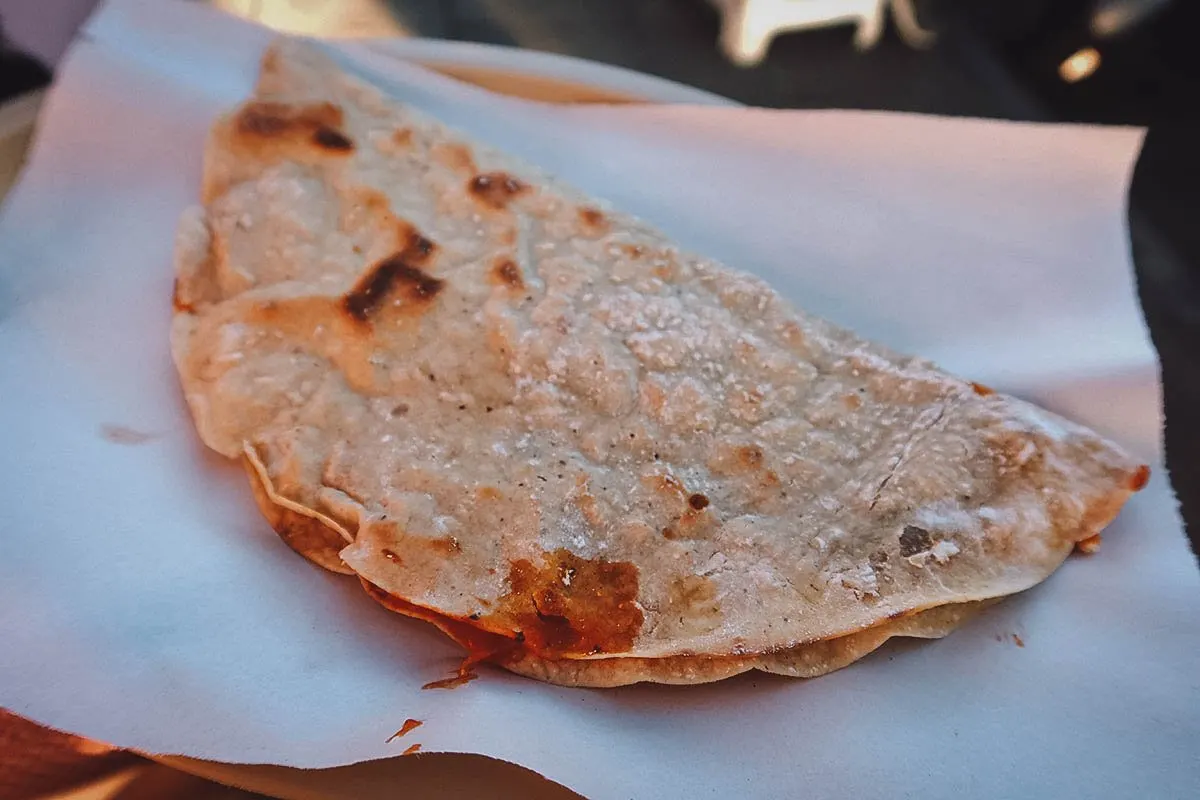
Molote
The molote is another large Mexican empanada, this time from Puebla. What makes it unique is that it’s made with a mixture of corn masa mixed with all-purpose flour, resulting in a pastry shell that’s much crunchier in texture than typical empanadas.
Molotes are deep-fried and can be filled with a variety of different ingredients like shredded chicken, huitlacoche (corn smut), quesillo, mushroom, and potato. They’re usually topped with crema (Mexican sour cream) and either green or red salsa.
Molotes topped with all three sauces are called “bandera”, because the green, white, and red sauces resemble the colors of the Mexican flag.
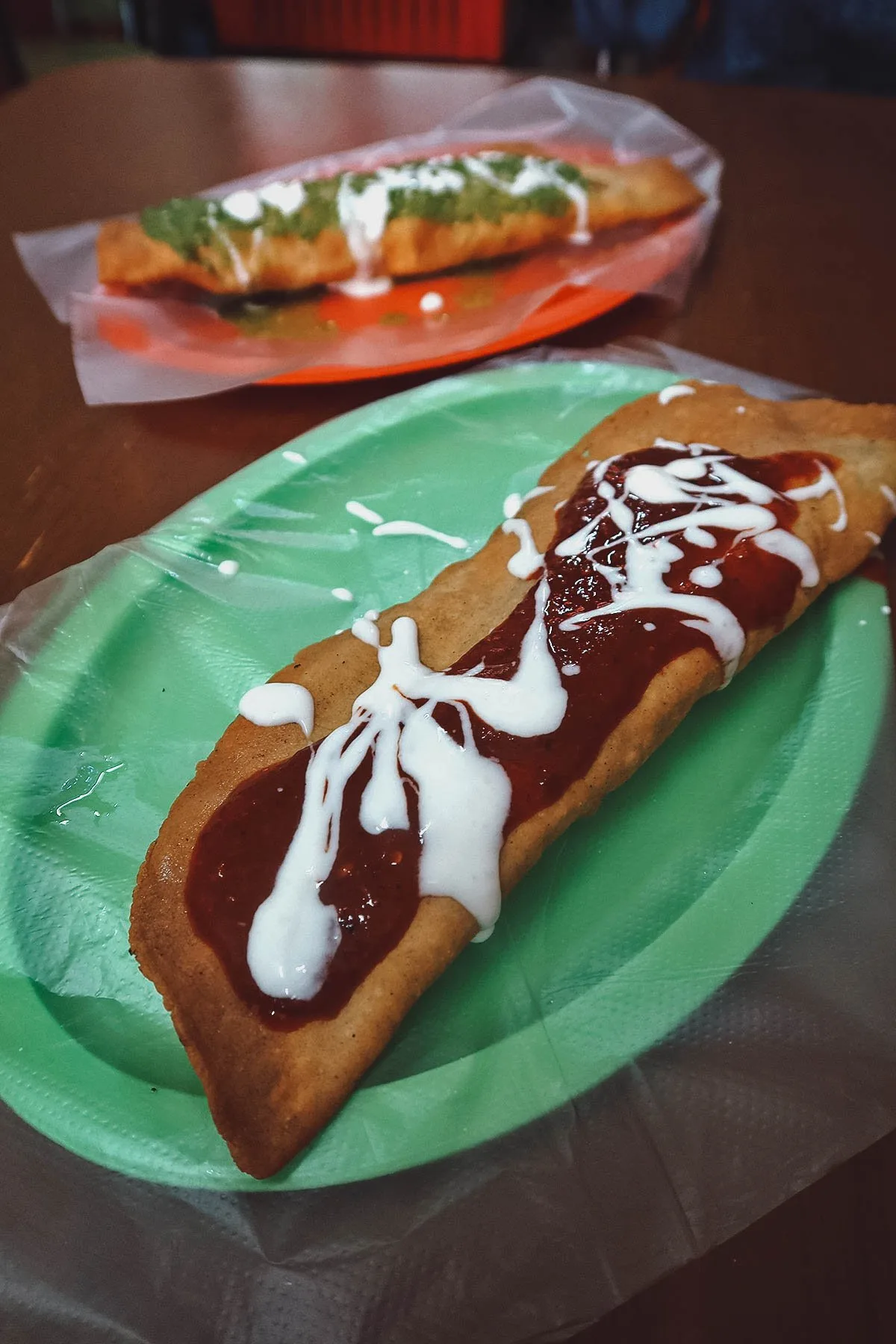
15. Insects
Entomophagy, the practice of eating insects, may be strange to some people but in Mexico, edible insects have been an important source of protein for thousands of years. Insects continue to form an important part of the local cuisine, especially in central and southern Mexican states like Oaxaca, Puebla, Guerrero, Chiapas, and Campeche.
If you’re spending time in CDMX, then a great place to try edible insects is Mercado de San Juan. Aside from carrying some of the best produce in the city, you’ll find a few stalls at the market selling insects like chapulines (grasshoppers), scorpions, Madagascar hissing cockroaches, maguey worms, and hormigas chicatanas (leaf-cutter ants).
I had a chocolate- and sesame-covered scorpion on a stick. It was good! Like a crunchy, chocolatey, sesame-covered potato chip.
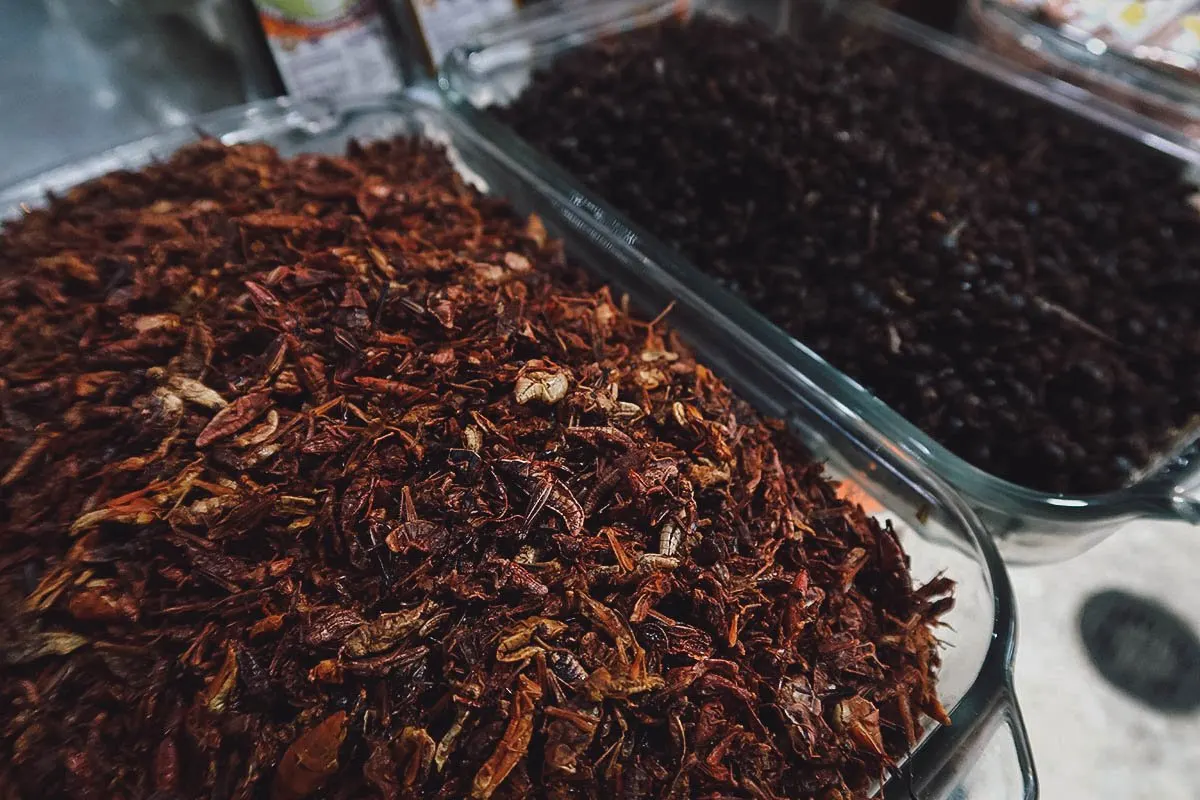
Chapulines
Chapulines or grasshoppers are among the most common edible insects you’ll find in Mexico. They’re especially popular in Oaxaca where you’ll find them sold at markets as a ready-to-eat snack, or served as an ingredient in tlayudas, tostadas, and omelettes.
Chapulines are well-seasoned with lime juice, garlic, chili, and salt so they make for tasty bar snacks. We once bought a small bag of chapulines from a market and took it to a mezcaleria in Oaxaca to enjoy with our mezcal tasting. Trust me, they go very well together.
By far the strangest dish we’ve had made with grasshoppers was nieves con chapulines. Nieves refer to water-based Mexican ice creams. They’re typically made with fruit but this one was flavored with chapulines. You couldn’t see the grasshoppers but you could definitely taste them!
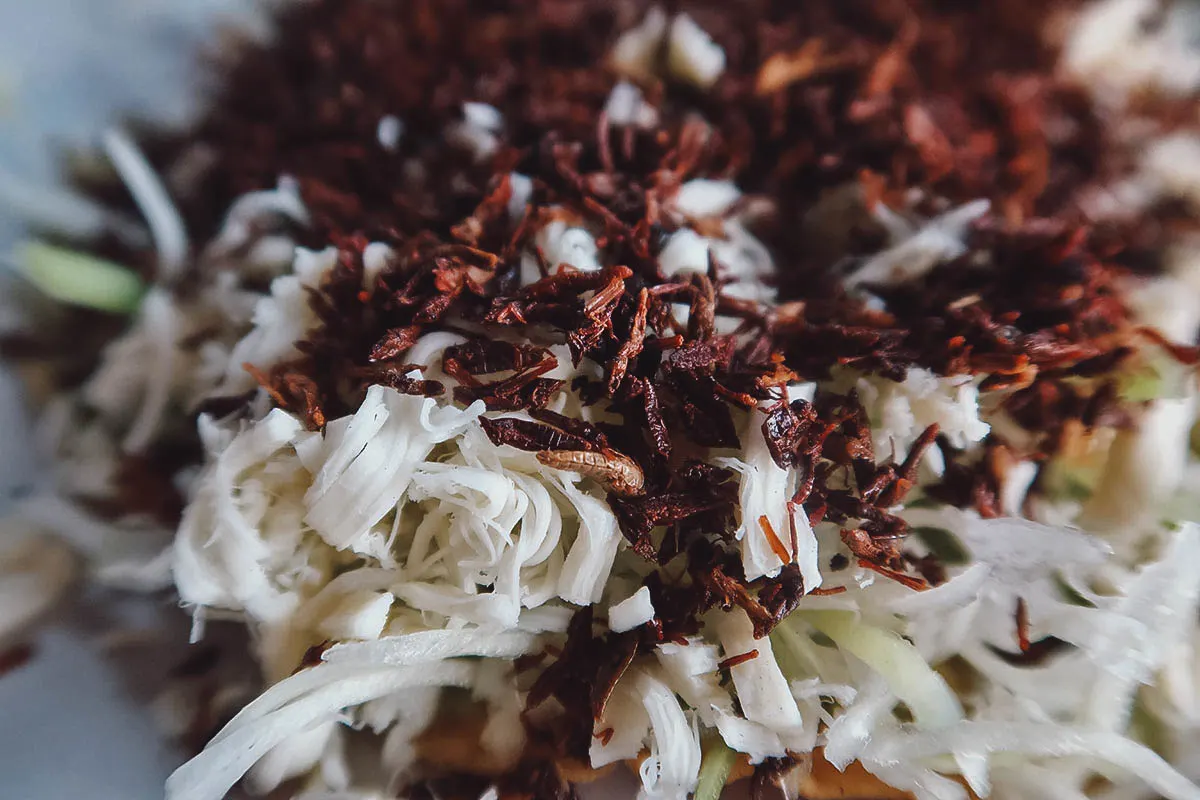
Chicatana
Hormiga chicatana or simply “chicatana” refers to a species of leaf-cutter ant (Atta mexicana). As you can see in the picture below, they’re a fairly large species of ant that’s typically harvested in central and southern Mexico during the rainy season, from around late May to early July.
Depending on the region, they can be prepared in different ways. They can be toasted on a comal and eaten as snacks, fried and eaten in tacos, made into sauces, or mixed into stews. According to a chef we met in San Miguel de Allende, they’re quite laborious to prepare because each ant has to be cleaned by hand.
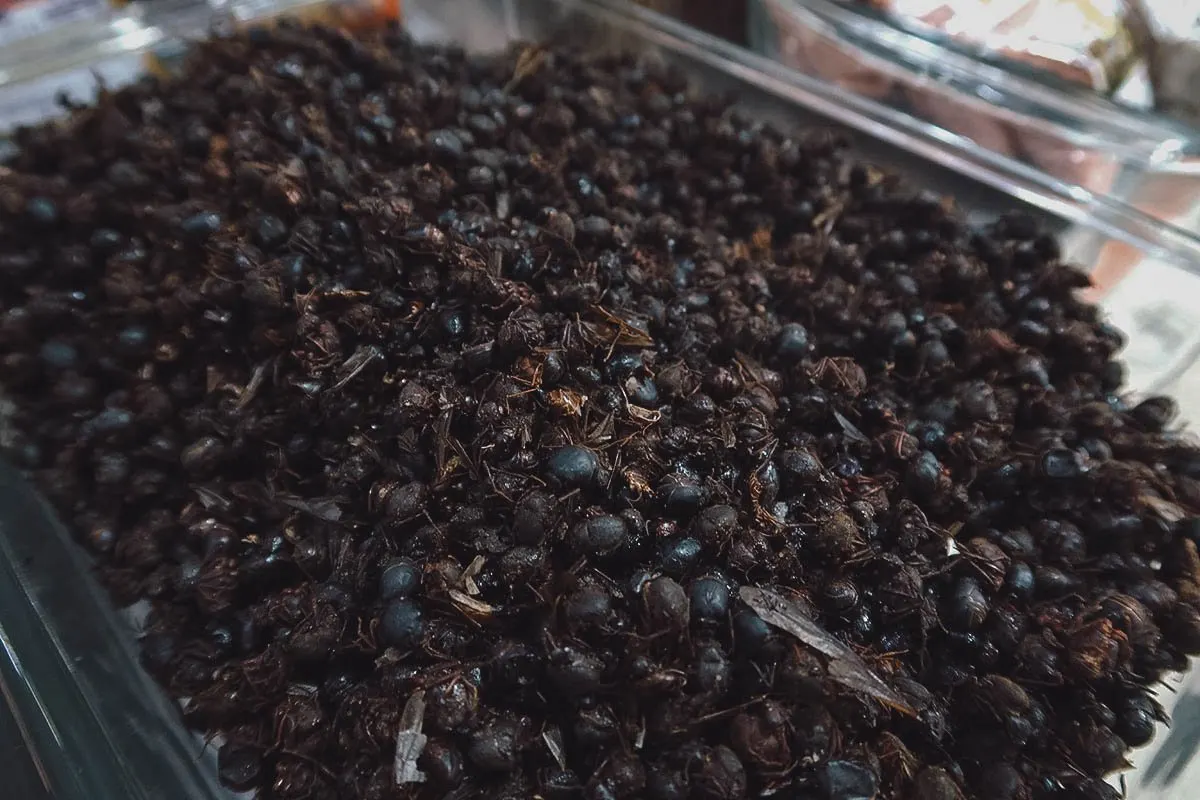
Chicatanas may be difficult to prepare but one taste of delicious dishes like this mole de hormiga chicatana makes all the effort worthwhile.
Isn’t this gorgeous? You eat the mole as a dip using the vegetables as scoops. We enjoyed this beautiful and very interesting dish at a restaurant in San Miguel de Allende.
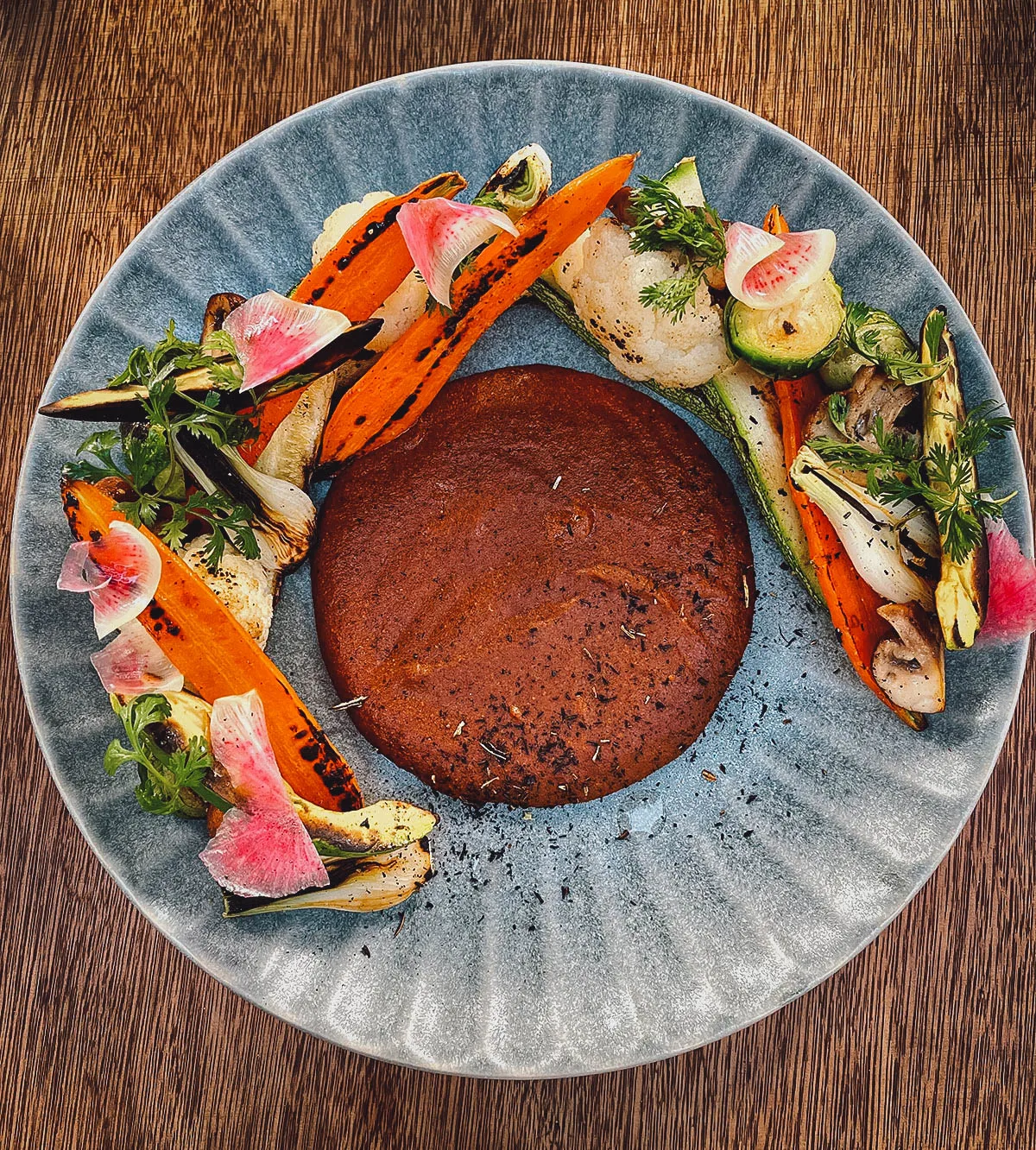
Escamoles
If you want the Rolls Royce of insect dishes in Mexico, then you need to look for escamoles. Known as “Mexican caviar”, it refers to a pre-Hispanic dish made with edible ant larvae and pupae.
We’ve been trying to find escamoles since February with no luck. It’s a highly seasonal dish that’s usually available in central Mexico around April and May. Apparently, it takes some skill to prepare them correctly so they’re typically served only at fancier restaurants. They’re quite expensive too, hence the nickname “Mexican caviar”.
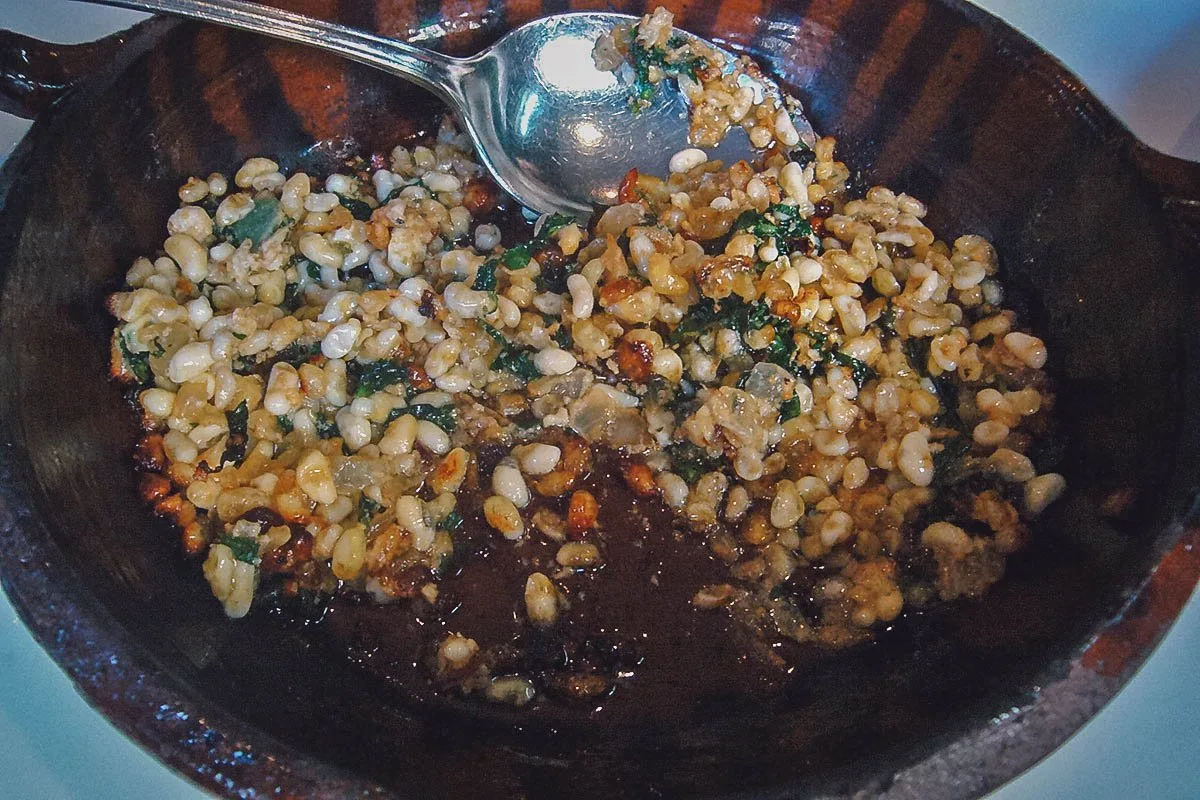
Escamole – ant eggs by Kent Wang, used under CC BY-SA 2.0 / Processed in Photoshop and Lightroom
PLATOS FUERTES (MAIN DISHES)
Platos fuertes means “main dishes” and refers to Mexican dishes that are typically served as entrees. Not all of the dishes in this section are classic platos fuertes (like pozole or ceviche), but they’re typically more common at restaurants than at roadside stalls so I decided to include them here.
16. Pozole
Pozole refers to a pre-Hispanic Mexican soup or stew that’s enjoyed throughout the country. Its key ingredient is hominy corn mixed with meat (usually pork or chicken) and other ingredients like shredded lettuce or cabbage, chili peppers, radishes, onions, garlic, avocados, and lime.
There are three main types of pozole in Mexico – rojo (red), verde (green), and blanco (white). Blanco is made without any additional red or green sauces while rojo and verde get their color from additional ingredients like red chili peppers, tomatillos, epazote (Mexican herb), and cilantro.
Pictured below is a supremely tasty bowl of pozole rojo from a restaurant in Oaxaca.
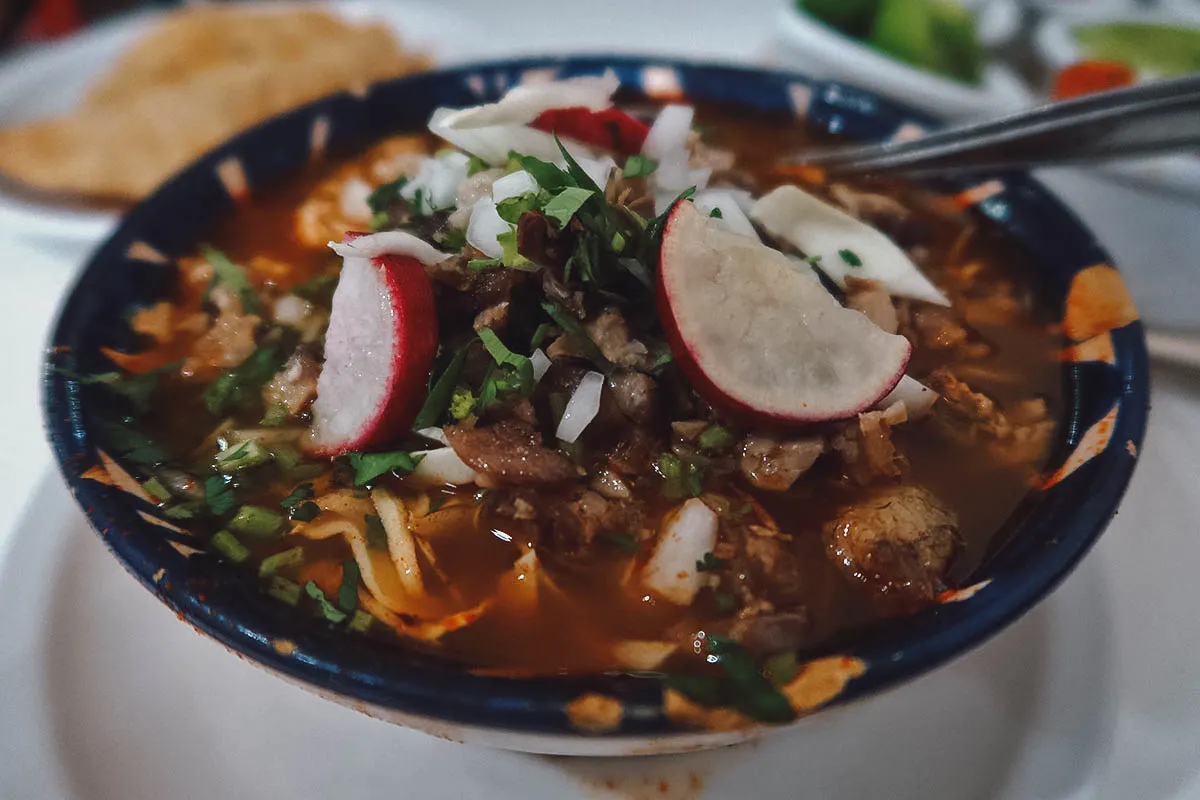
17. Ceviche / Aguachile
Ceviche is a popular South American seafood dish originally from Peru. It’s made with fresh raw fish cured in fresh citrus juices, most commonly lime or lemon.
Ceviche can be found throughout Mexico but as you’d expect, it’s especially popular in coastal cities. This version from a restaurant in Puerto Vallarta was made with tilapia, onion, wild carrot, cucumber, cilantro, and serrano pepper.
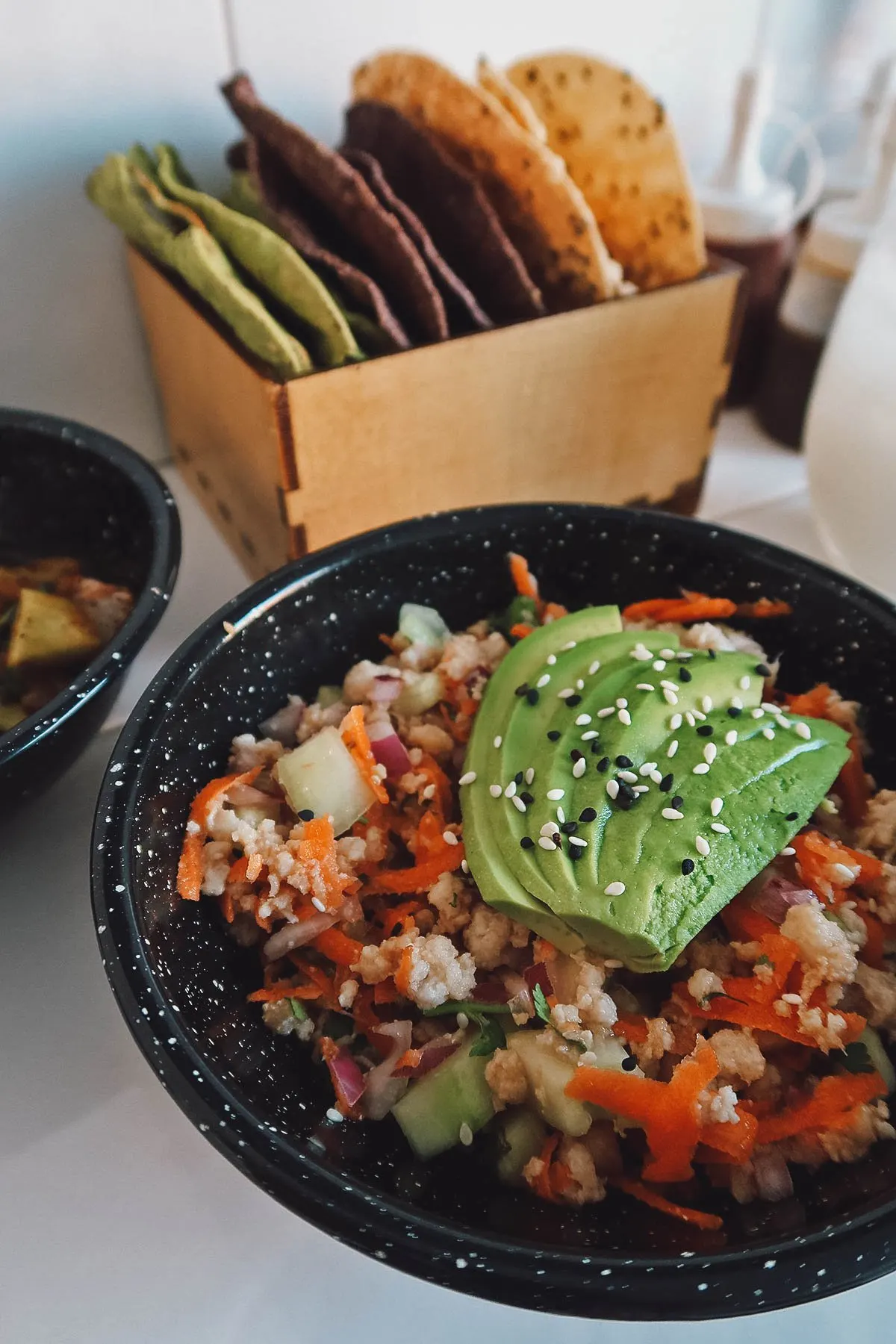
Equally popular in Mexico is aguachile, a similar seafood dish that’s made with raw shrimp instead of fish. Unlike ceviche that’s originally a Peruvian dish, aguachile is a homegrown Mexican dish hailing from the western coastal state of Sinaloa.
What you’re looking at below is a version of aguachile from the same restaurant in Puerto Vallarta. It’s made with shrimp, cucumber, onion, cilantro, and salsa served with a side of crunchy tostadas.
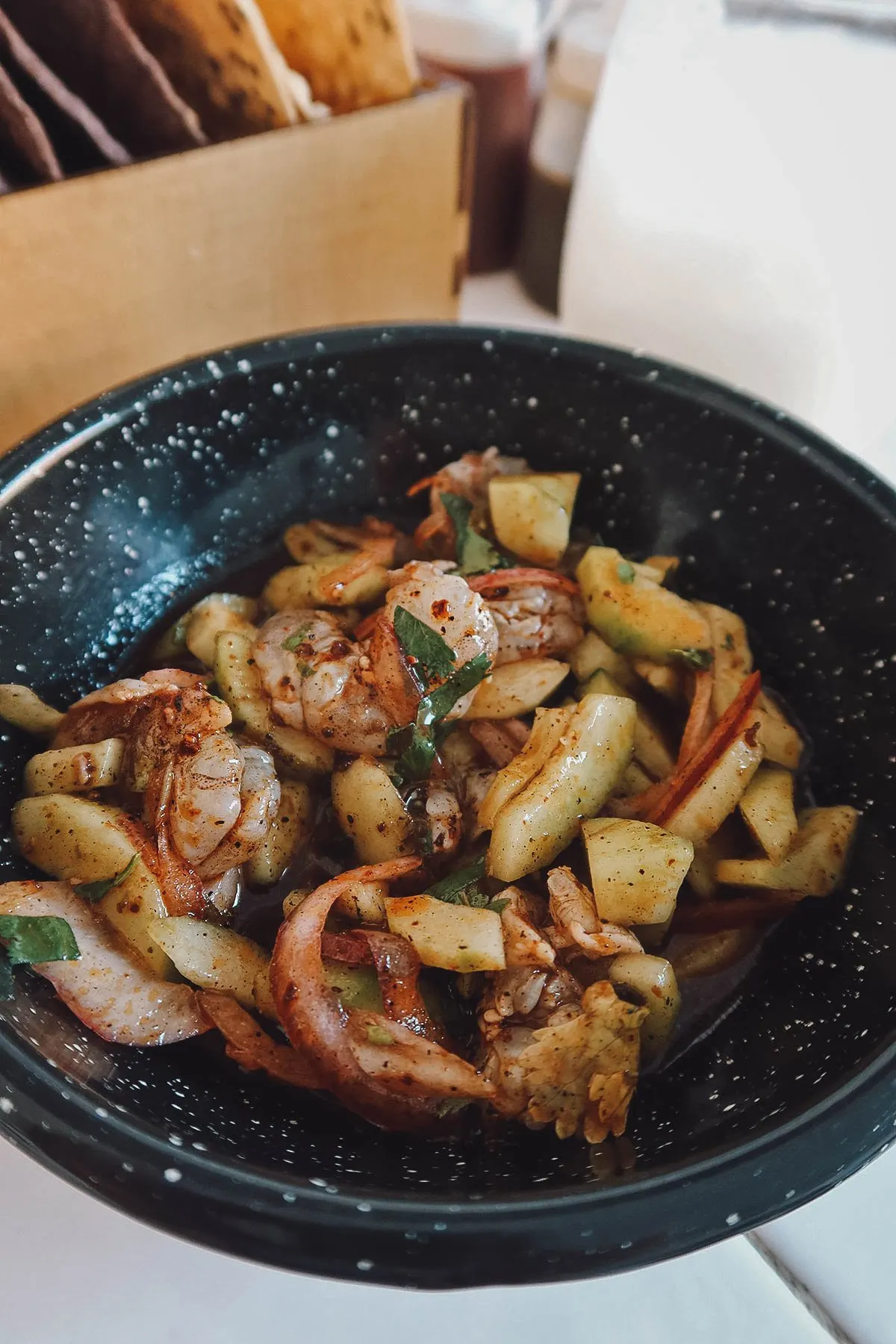
18. Burrito
Like tacos and quesadillas, burritos are among the most popular Mexican dishes outside of Mexico. In fact, they’re so popular in the US that they’re often mistaken for Tex-Mex or Cal-Mex dishes rather than being authentic Mexican food.
The truth is, burritos are a traditional food in the northern Mexican state of Chihuahua. It’s especially popular in Ciudad Juárez, a city that borders El Paso, Texas. I went on a food tour in Mexico City and according to my guide, burritos crossed the border and became so popular that many people believed that they actually originated in the US.
The original Mexican version of the burrito is relatively small and thin. It’s made with a flour tortilla filled with just one or two ingredients. In comparison, the US version is much heftier and can be filled with over half-a-dozen ingredients like shredded beef, lettuce, beans, rice, sour cream, guacamole, salsa, and cheese.
Outside of northern Mexico, the classic Mexican burrito isn’t that common but you can find it in popular tourist destinations like Puerto Vallarta and Tulum.
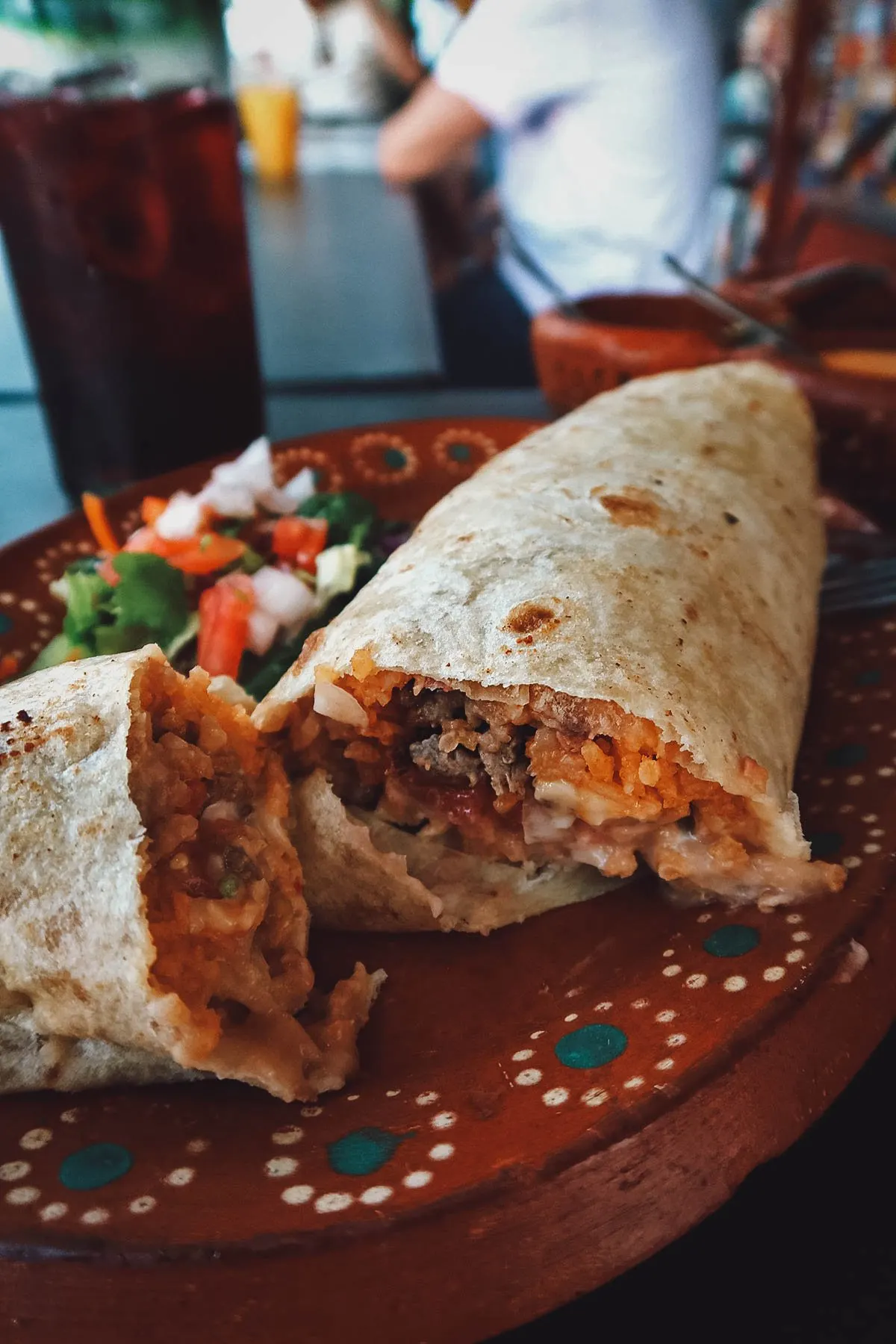
19. Mole
Mole is one of the most important dishes in Mexican food culture. Meaning “sauce” in Nahuatl, it doesn’t refer to a single dish but to a family of sauces often used in Mexican cuisine. Mole is considered by many to be the pinnacle of Mexican gastronomy and is perhaps one reason why traditional Mexican food was given Intangible Cultural Heritage status by UNESCO.
There are hundreds of known mole recipes throughout Mexico, many of which are incredibly tedious and laborious to make. Among the most famous are mole poblano and Oaxaca’s seven moles (pictured below).
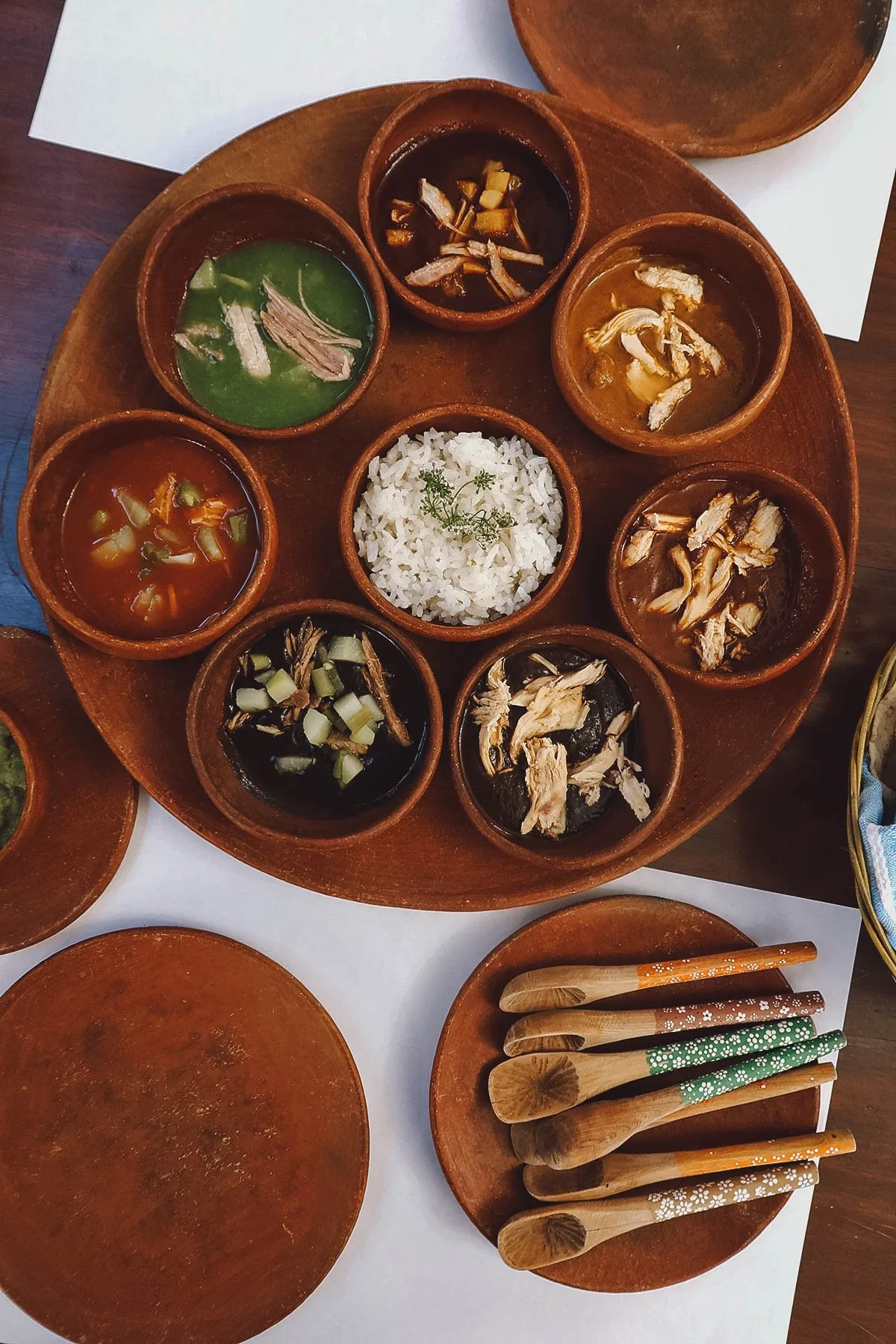
Mole Poblano
Mole poblano is the most famous mole in Mexico. When someone says “mole”, the first mole that usually comes to mind is mole poblano. It’s a Mexican classic from Puebla that’s viewed by many as the national dish of Mexico.
Mole poblano is a thick dark sauce made with over twenty ingredients like cocoa, different types of chili peppers, almonds, bananas, walnuts, raisins, tortillas, and spices. It’s intensely rich in flavor and typically served over chicken or pork with a side of corn tortillas and rice.
Needless to say, mole poblano is a must-try dish in Puebla. It’s believed to have been invented in the 16th century by nuns who improvised and used whatever ingredients they had to prepare a dish for the visiting archbishop.
If you’d like to make this iconic Mexican dish yourself, then you’ll definitely want to check out our authentic mole poblano recipe. It was developed by a renowned local chef who runs a popular cooking class in Puebla.
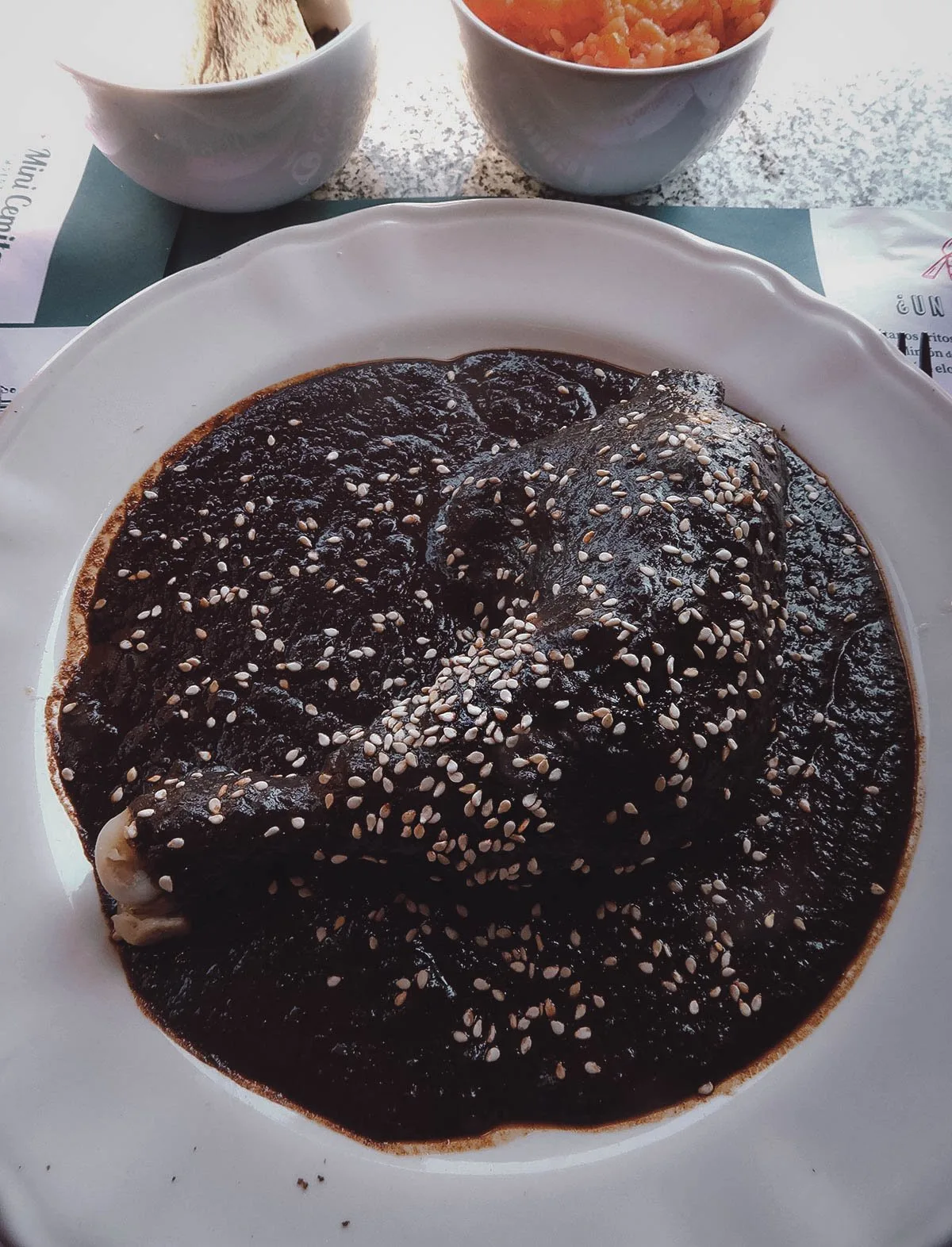
Pipian
I’m not entirely sure if pipian qualifies as a true mole, but it’s another traditional sauce that you can find in Puebla. Pipia refers to any Mexican sauce made with pepitas (pumpkin seeds) as its main ingredient.
In Puebla, you can find two types of pipian – pipian rojo (red) and pipian verde (green). They’re made with ground toasted pumpkin seeds mixed with a plethora of other ingredients. They’re typically served in the same way as mole poblano – over chicken with a side of rice and tortillas.
Pictured below is a mole degustation platter from a restaurant in Puebla. It contains mole negro, pipian verde, pipian rojo, and another type of Mexican mole called mole blanco (white).
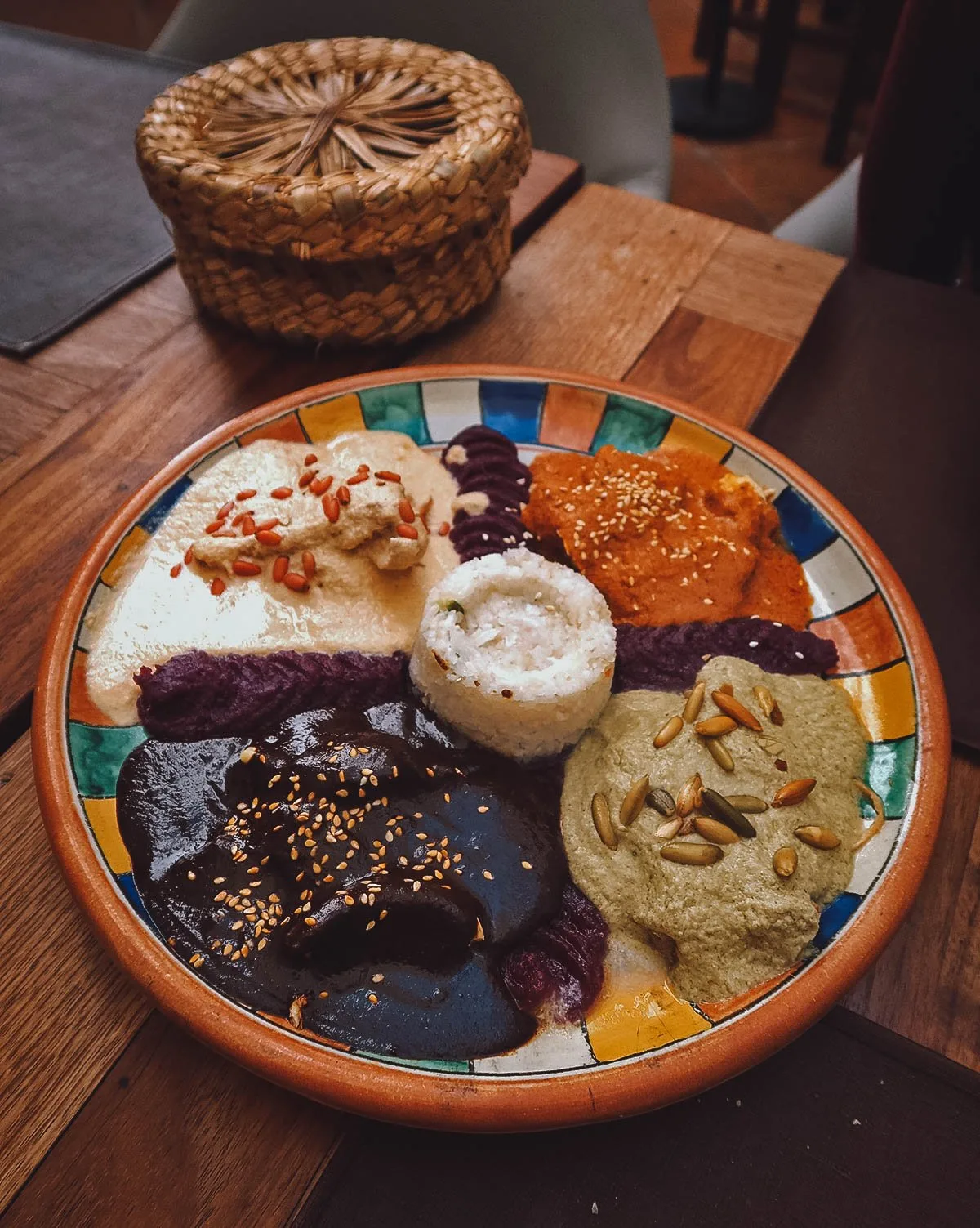
Mole Negro
Mole negro is the most famous of the seven moles in Oaxaca. It’s also the most difficult to prepare and typically contains over thirty ingredients including six types of chili peppers.
We had dinner with a local Oaxaqueño one night and according to him, a proper mole negro takes about three days to prepare from scratch. Like mole poblano, mole negro is a no-brainer. It’s a definite must-try in Oaxaca.
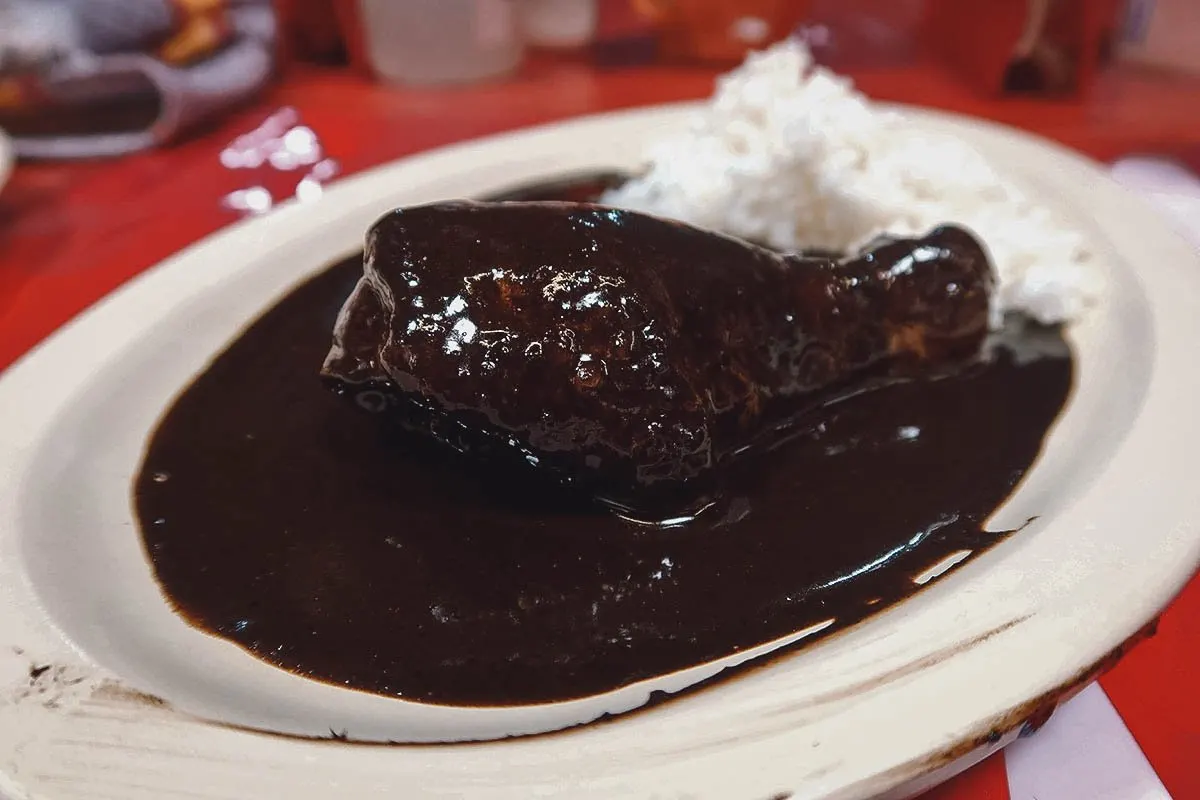
Mole Coloradito
After mole negro, mole coloradito is perhaps the second most well-known mole in Oaxaca. Meaning “reddish” or a “little red” in Spanish, coloradito refers to a reddish-brown sauce that isn’t as rich as mole negro. I like them both but personally, I prefer mole coloradito. It’s more of an everyday type dish.
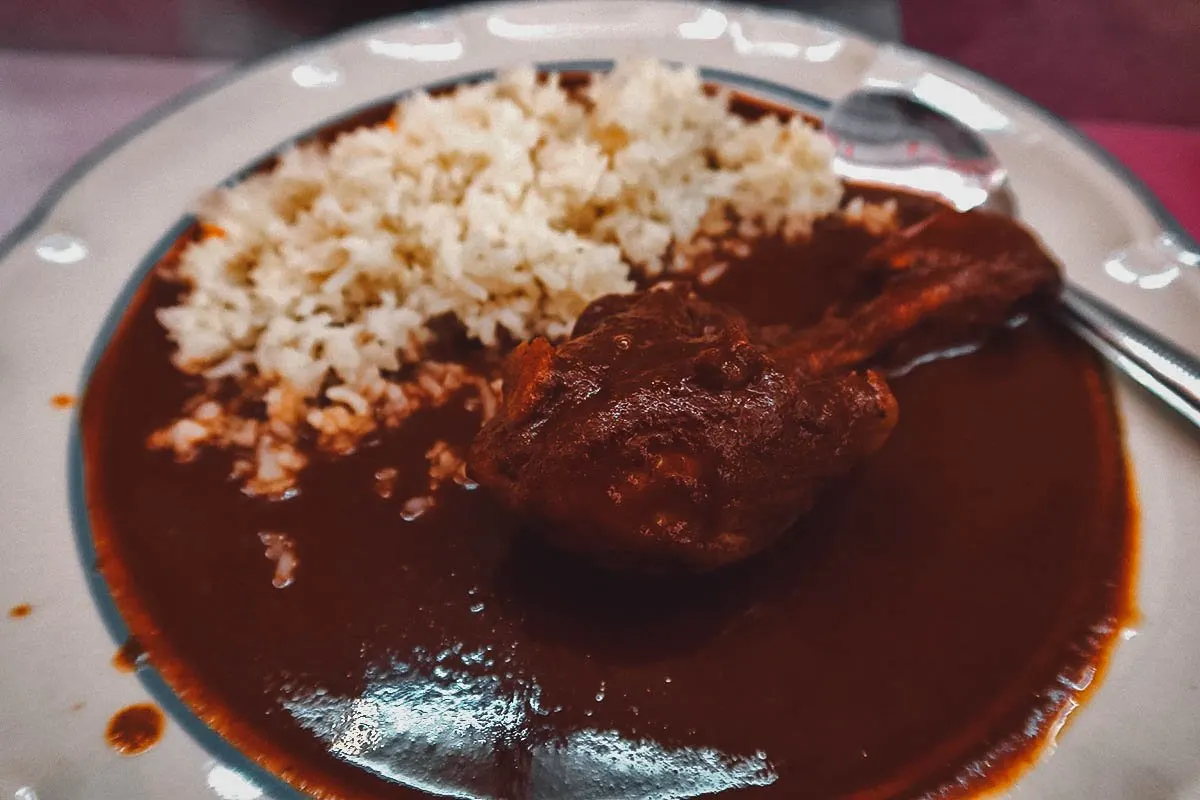
20. Chiles en Nogada
Chile en nogada has to be one of the prettiest dishes in Mexican cuisine. It’s another signature dish of Puebla that’s considered by many to be a Mexican national dish.
Chile en nogada is a seasonal dish made with a large poblano pepper stuffed with a picadillo mixture. The stuffed pepper is then drenched in a walnut-based cream sauce and garnished with pomegranate seeds and parsley.
As described, chile en nogada is a seasonal dish that’s typically available only in August and September when pomegranates are in season. It also coincides with Mexican Independence Day. It’s a celebratory dish whose main ingredients are said to resemble the colors of the Mexican flag – poblano pepper for green, walnut cream sauce for white, and pomegranate seeds for red.
Touristy restaurants in Puebla will serve chiles en nogada at other times of the year (using tasteless pomegranate seeds), but it’s best to try it when it’s in season. It’s a beautiful dish and one of the best things we’ve eaten so far in Mexico.
If you’d like to try making it yourself, then be sure to check out our chiles en nogada recipe. It was developed by the same chef as the recipe for mole poblano.
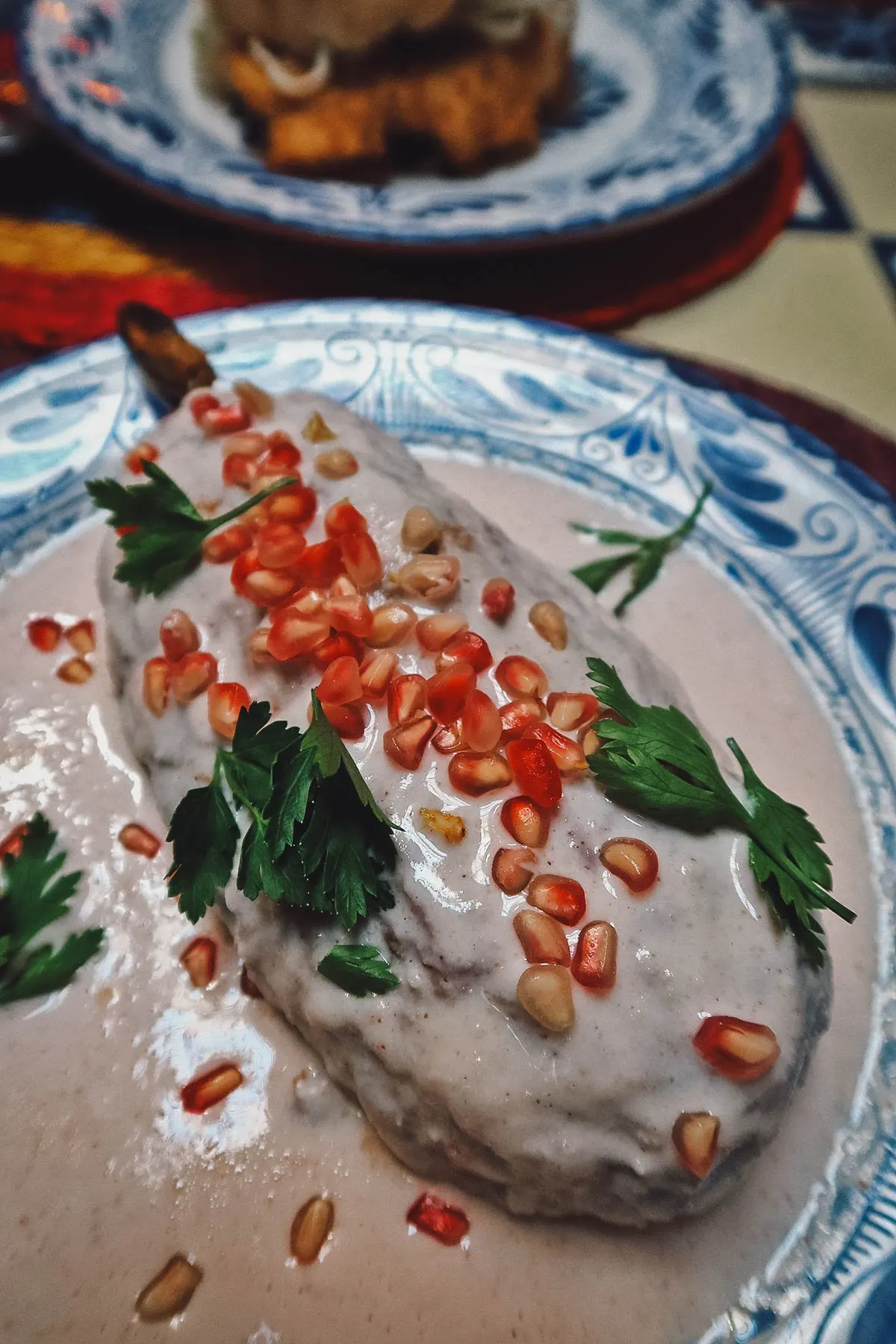
21. Barbacoa
Mexicans love a good barbecue. It’s a cooking tradition that originated in the Caribbean with the Taino people, who called it barbaca. Barbaca became “barbacoa”, and ultimately “barbecue”.
In Mexico, barbacoa is a general term used to describe the method of slow-roasting meats over an open fire, traditionally in a pit dug in the ground and covered with maguey leaves. It exists in different variations throughout Mexico but the tradition seems strongest in the central Mexican state of Hidalgo.
On the plate below are three tacos filled with Hidalgo-style barbacoa. Barbacoa can be made with different types of meat but in Hidalgo, the meat of choice is lamb. For many Mexican families, it’s a weekend tradition that’s typically enjoyed for breakfast.
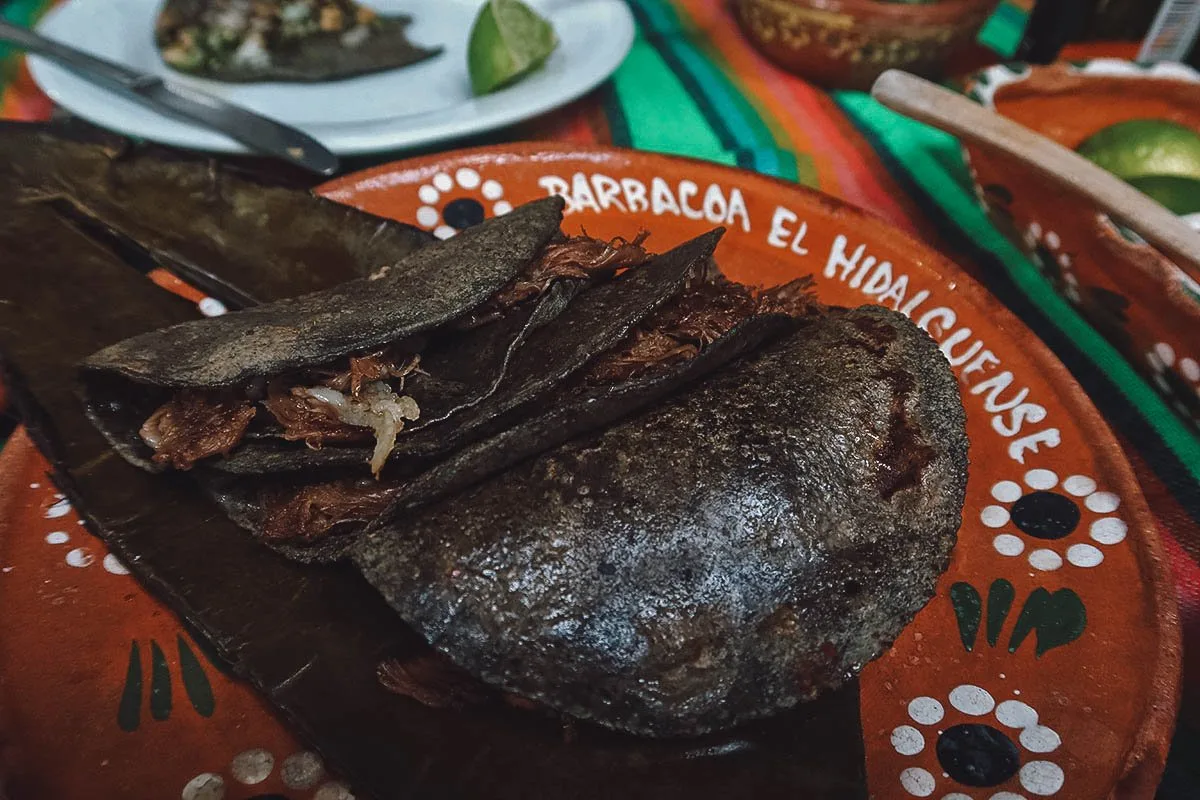
Birria
Birria is a type of Mexican goat stew from Guadalajara and Jalisco state. It’s often confused with barbacoa but they’re not the same thing. Barbacoa pertains to a cooking process while birria is a specific dish that can be made from barbacoa meat.
Birria refers to a delicious dish made with slow-cooked spicy goat meat adobo served in a soup or stew with garlic, cumin, thyme, and bay leaves. It can be cooked entirely in a pot but it can also be prepared using pit-cooked barbacoa meat.
No matter how it’s prepared, it’s something that you absolutely need to try in Guadalajara.
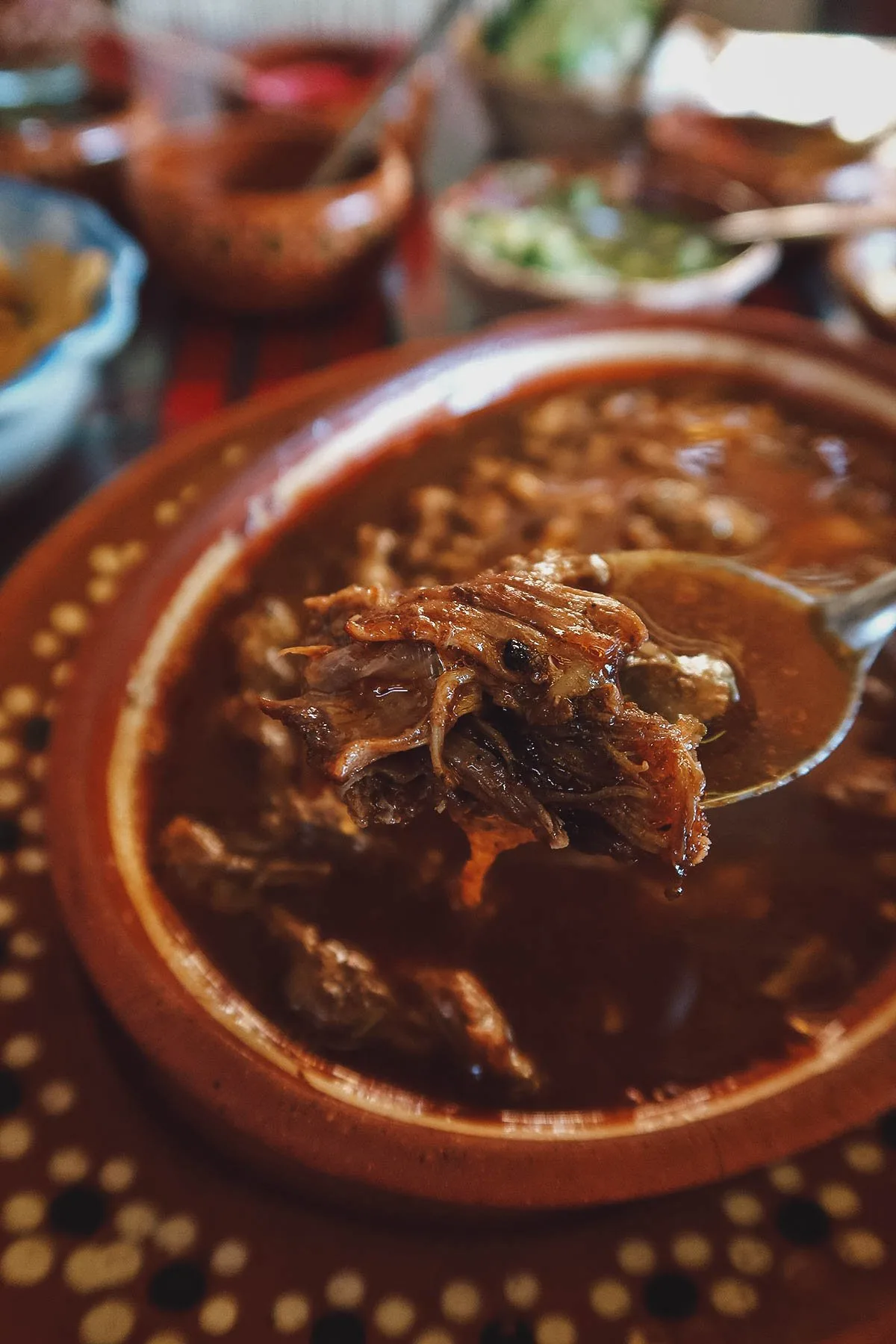
Cochinita Pibil
Cochinita pibil is the most famous dish from the Yucatan Peninsula. It refers to a type of barbacoa made with slow-roasted pork marinated in sour orange juice and achiote. The marinated pork is then wrapped in banana leaves and cooked in an earthen oven for up to 16 hours.
Like any type of barbacoa, this slow-cooking process results in a Mexican meat dish that’s incredibly tender and juicy. Popular in Merida, Valladolid, and any other city in the Yucatan, cochinita pibil is typically eaten in salbutes, panuchos, tacos, or tortas.
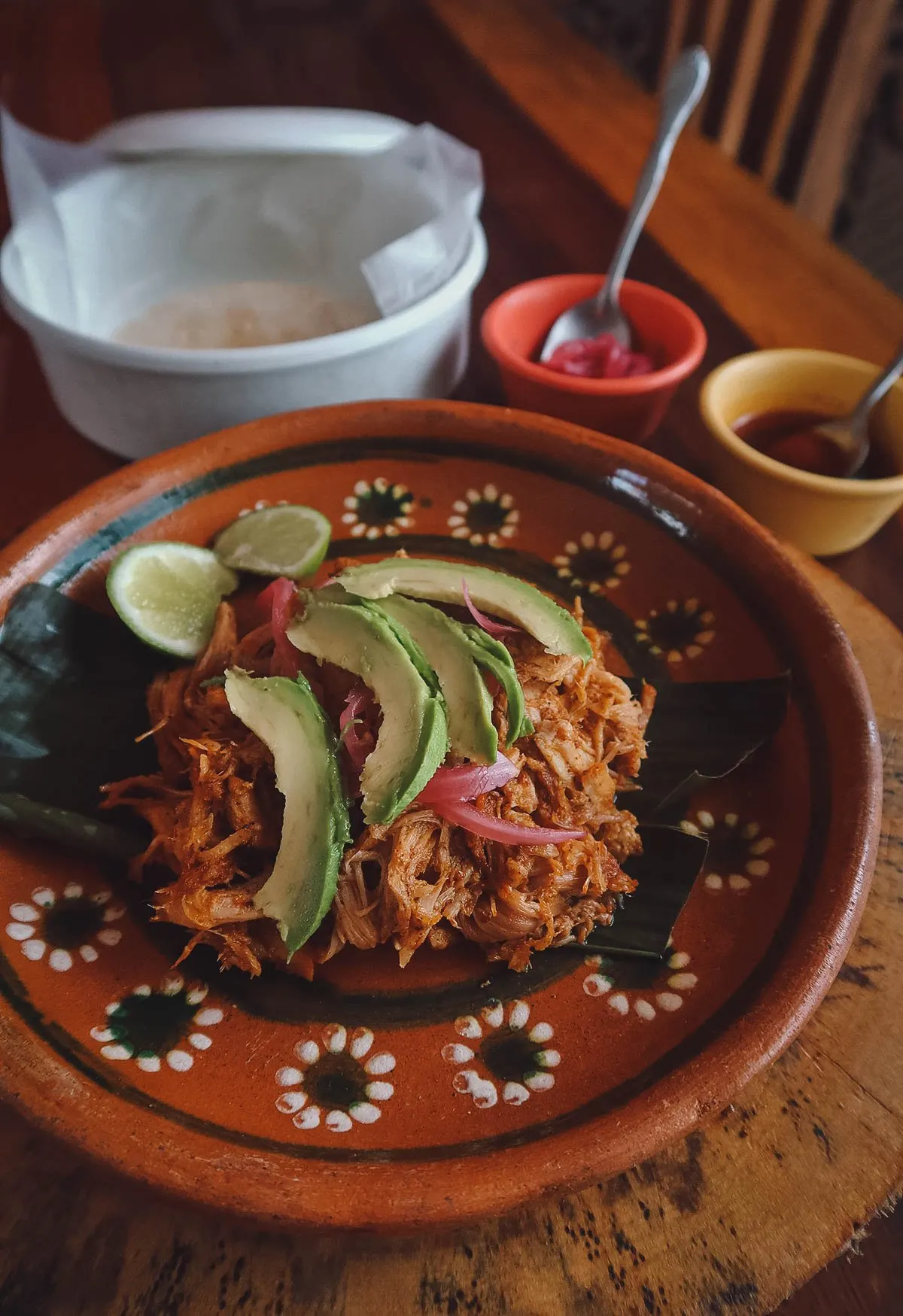
22. Carne en su Jugo
Carne en su jugo is another specialty meat dish from Guadalajara. It literally means “meat in its own juices” and refers to a dish made with thin slices of beef steak (ala Philly cheesesteak) cooked in its own juices and then served with bits of bacon and beans.
Like many Mexican meat dishes, it’s typically served with corn tortillas and a few side dishes like refried beans, chopped onions, cilantro, and salsa.
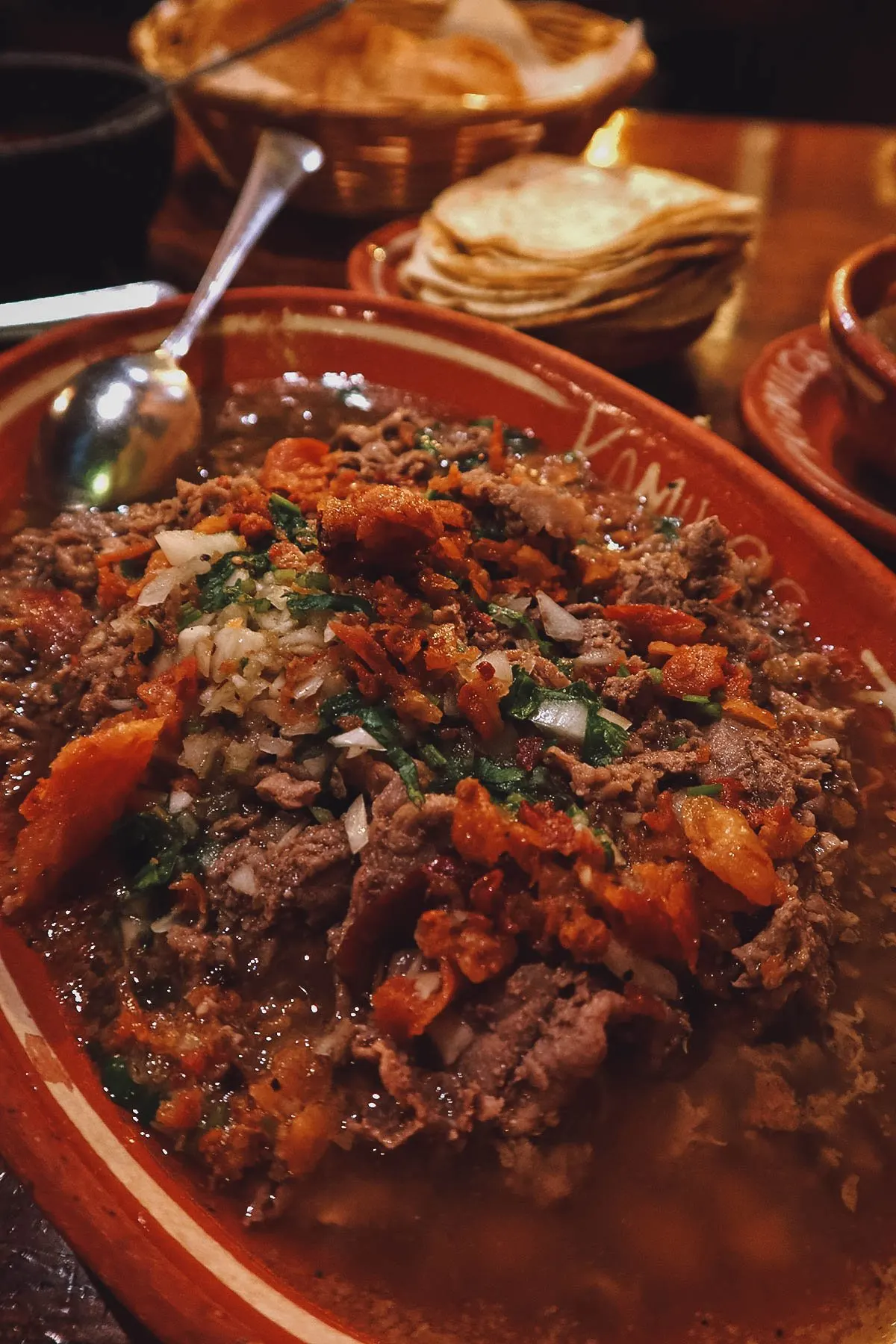
DESSERTS
23. Flan
One of the most common desserts you’ll find on a Mexican restaurant’s menu is flan napolitano. It’s basically the Mexican version of a creamy custard dessert popular in many countries around the world like Spain, Portugal, Brazil and the Philippines.
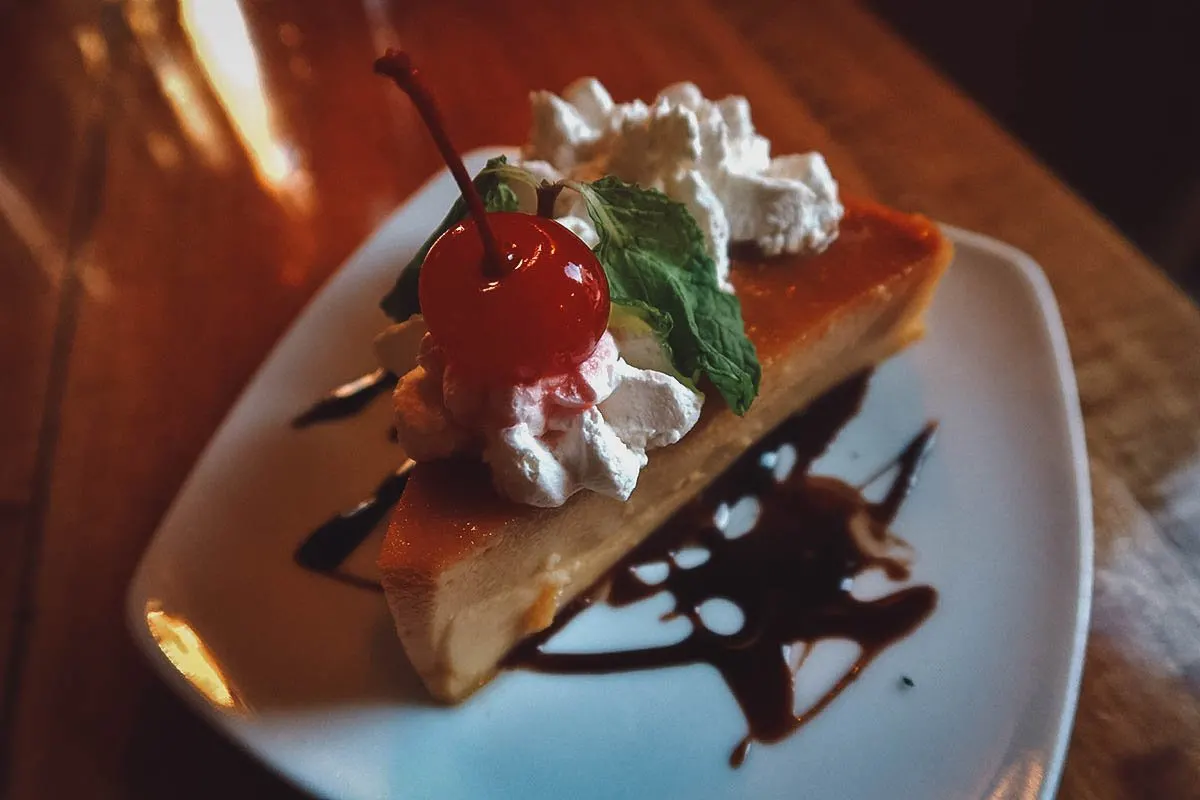
Jericalla
Originally from Guadalajara, Jericalla is a type of Mexican flan that’s baked in uncovered individual molds. Similar to creme brulee, it has a sightly burnt top that’s browned under a broiler.
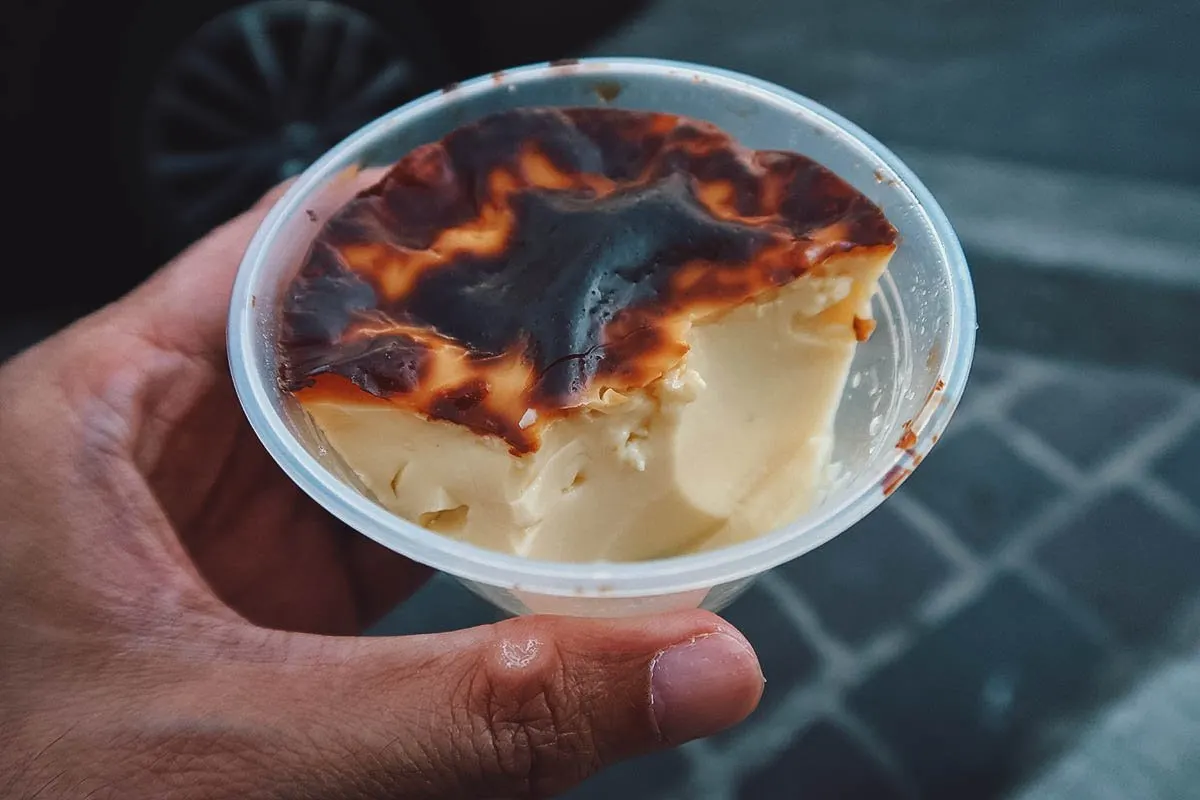
24. Raspados
You can find raspados everywhere in Mexico. Sold from mobile street carts and raspado stalls, it’s a Mexican dessert made with shaved ice sweetened with a wide array of flavored syrups like mango, tamarind, nut, pineapple, and soursop.
In my hand below is a cookies and cream with rompope (Mexican eggnog) raspado. It’s drizzled with chocolate sprinkles and served with an Oreo cookie.
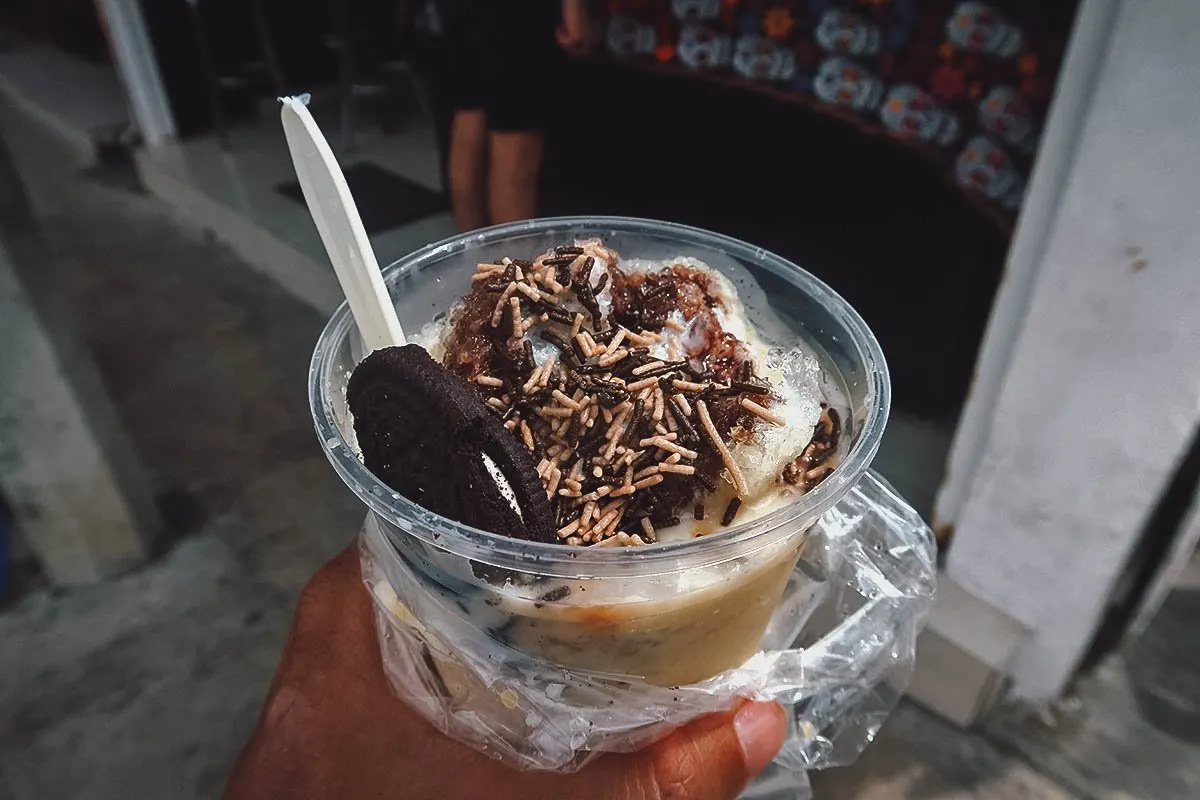
Machacados
Machacados aren’t raspados but they’re very similar. Originally from Chetumal in Quintana Roo, it’s a shaved ice dessert topped with crushed fruit and condensed milk instead of the usual flavored syrups. They’re really good.
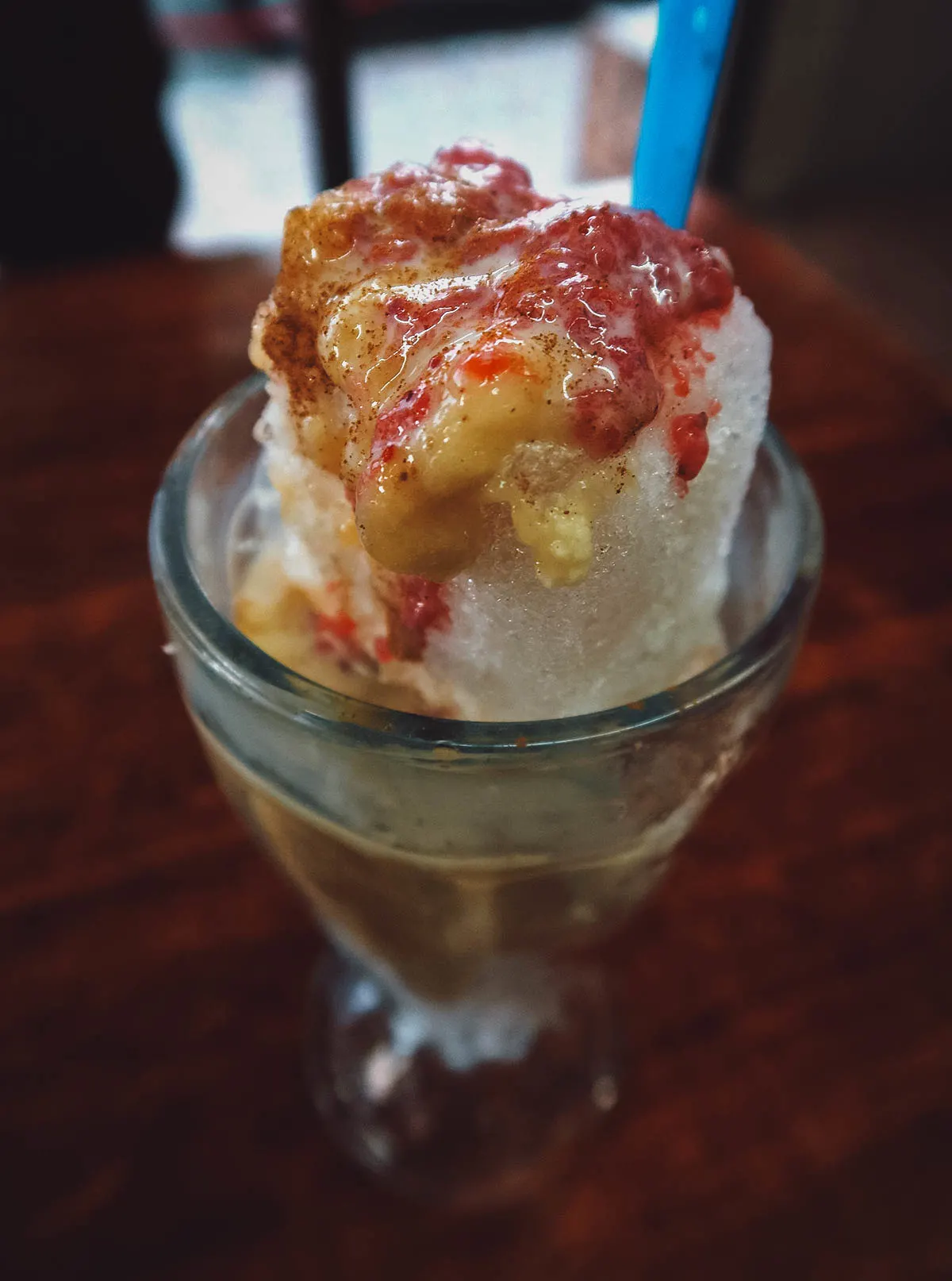
25. Nieves
You’ll typically find these three words on a Mexican ice cream shop’s menu – helados, paletas, and nieves. Paletas are frozen popsicles while helados are your usual milk-based ice creams. All three are delicious but nieves may be the most interesting.
Meaning “snow” in English, nieve refers to a type of Mexican water-based ice cream flavored with natural fruits and other ingredients. You can think of it as a Mexican version of sorbet.
Though I prefer the creaminess of helados, nieves are often made with more interesting flavors like chamoy (pickled fruit), tequila limon, mezcal, and maracuya (passionfruit).
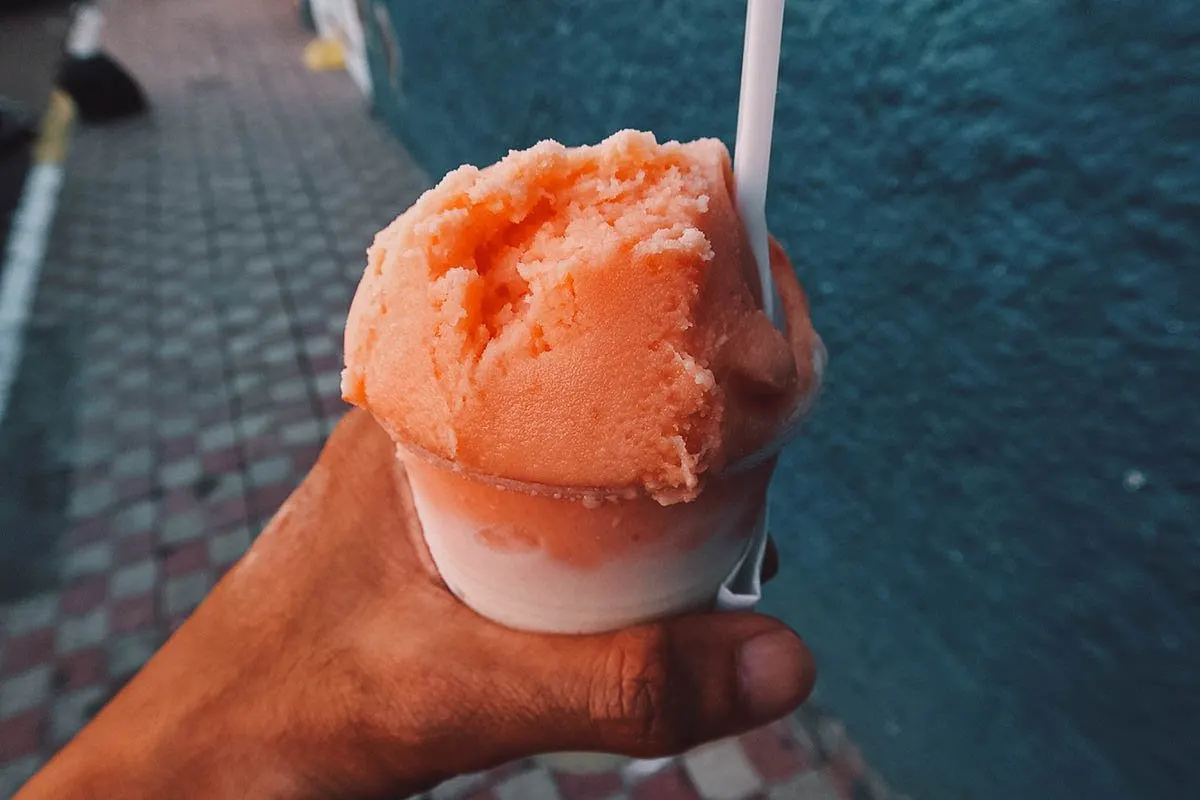
FINAL THOUGHTS ON TRADITIONAL MEXICAN FOOD
We’ve been living in Mexico for four months now but we’re only just beginning to scratch the surface of Mexican cuisine. We learn a little more after each new city and state we visit so we’ll continue to refine and add to this guide the longer we stay in Mexico.
We’ve eaten our way through seven Mexican states thus far and will be exploring at least eight more in the coming months. I can’t wait to add to this guide and share what we find with all of you.
Until then, thanks for reading and have an amazing time sampling all the delicious food in Mexico.
Disclosure
Some of the links in this article on Mexican food are affiliate links. If you make a booking, then we’ll earn a small commission at no additional cost to you. As always, we only recommend products and services that we use ourselves and firmly believe in. We really appreciate your support as it helps us make more of these free travel and food guides. Thank you!

